

Guide To The Ara Pacis Museum: Ancient Rome’s Altar of Peace
The Ara Pacis, or Altar of Peace, is one of Ancient Rome’s most significant monuments. Built in the 1st century BC, this 2,000 year old altar symbolizes the peace and prosperity of Emperor Augustus’s reign.
When the Roman Senate commissioned the Ara Pacis, Augustus had triumphantly returned from conquering Spain and Gaul. The altar was intended to burnish Augustus’s image, making him the symbol of the new Roman golden age.
It’s adorned with imagery from Rome’s history, of Augustus’ accomplishments, an the Imperial family. The message was loud and clear. Peace had returned thanks to Augustus.
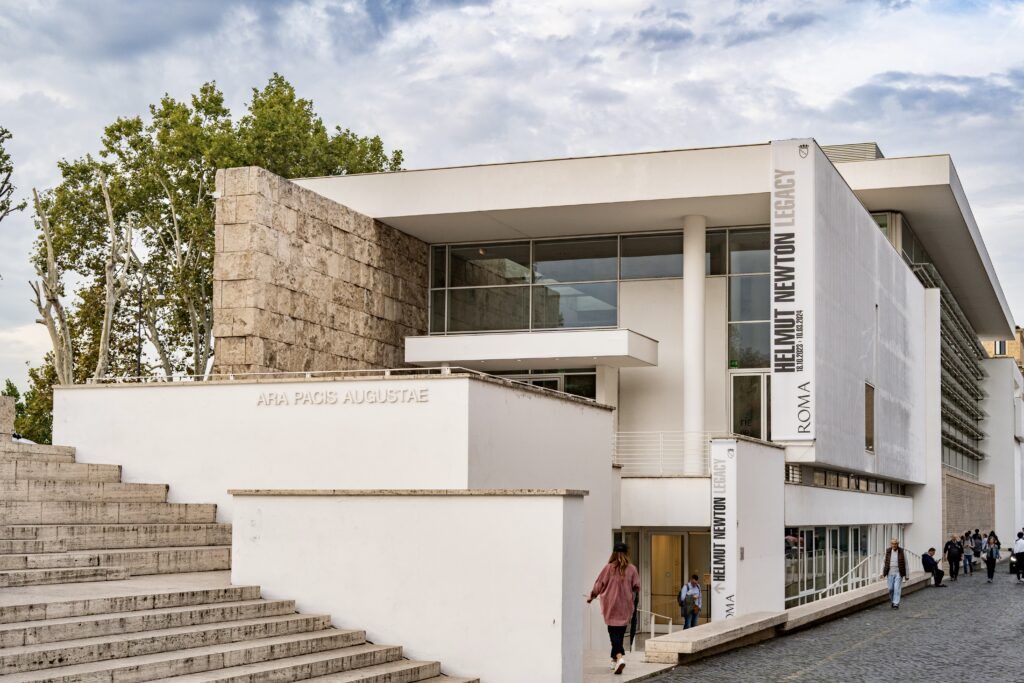
Yet, the Ara Pacis is more than a statement of political power. It’s also a stunning example of Roman art, serving as a portal to a distant era.
This guide to the Ara Pacis gives you a short history of how it came to be and tells you what you can see today.
>>> Click here to pre-book a skip the line ticket
Mini History of Ara Pacis
To understand the altar’s importance, you need a short history.
Augustus was the adopted son and successor of Julius Caesar. He became Rome’s first emperor in 27 BC.
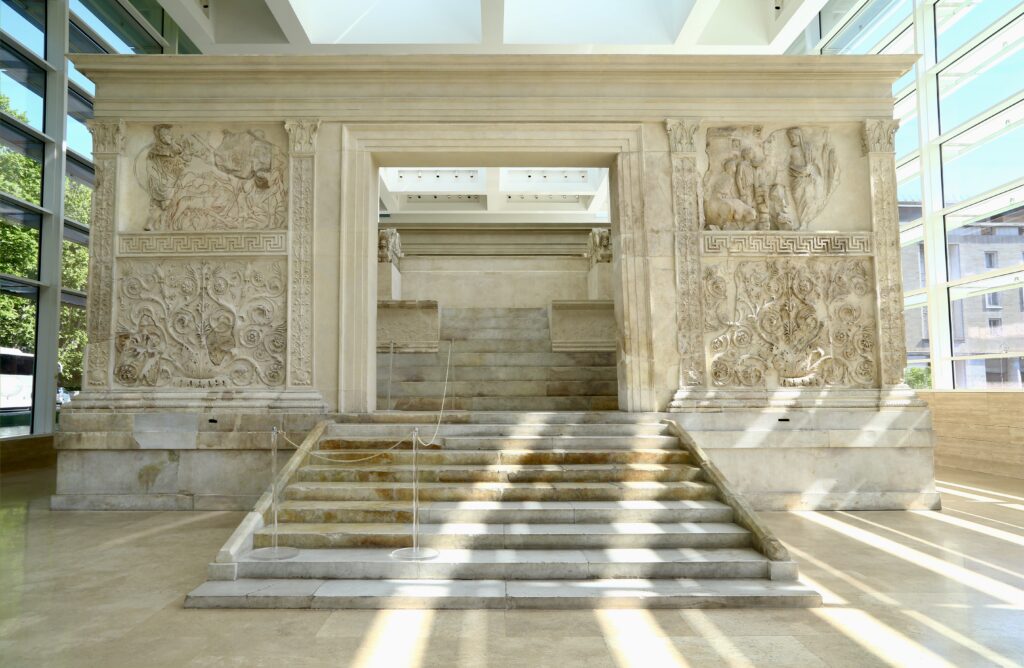
To rise to power, Augustus avenged Caesar’s assassination and defeated rivals for the throne, including Mark Antony. He further cemented his authority with successful military campaigns in Spain and Gaul.
After his victories, Augustus shifted from conqueror to stable and responsible leader. Following years of war, he focused on establishing the rule of law and ushered in a period of unparalleled peace known as the Pax Romana .
The Altar of Peace was built to honor the peace and prosperity of Augustus’ reign. It stood on the Campus Martius and was used as an open air altar for animal sacrifices associated with the Roman religion.
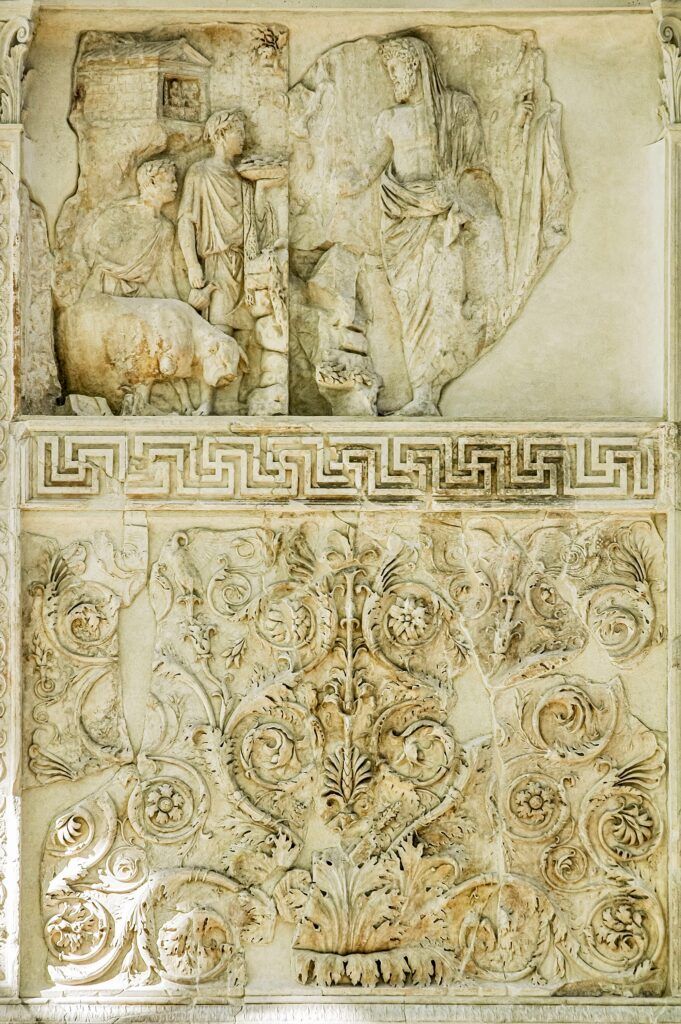
With the fall of Rome, the altar was destroyed by barbarians. It was buried beneath the ground, forgotten until the Renaissance when bits and pieces resurfaced.
In the 1930s, after further excavations, art historian and archaeologist Giuseppe Moretti recognized that the fragments belonged to the famed Ara Pacis.
Mussolini ordered a concerted effort to reconstruct the altar. The initiative was part of his broader strategy to link his regime with the illustrious Augustus.
The process took decades. Indeed, it was a bit of a miracle that it could be reconstructed at all since it had been lost to memory.
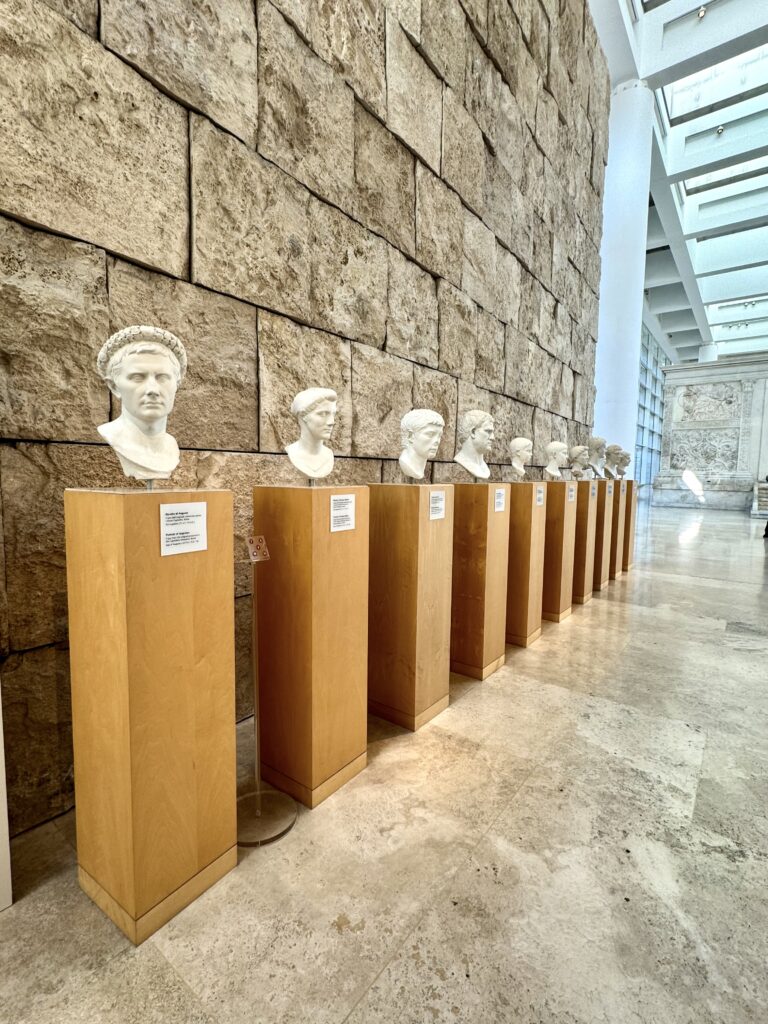
Initially, the reconstructed Ara Pacis was housed in a provisional, protective building near its original location along the Tiber River. But it wasn’t adequate for long term preservation of the monument.
In 2006, renowned American architect Richard Meier was commissioned to build a new home for the altar. He had had just completed the Getty Center in Los Angeles. Meier created an ultra modern space of glass and travertine.
The building was controversial. It was considered too expensive and offended traditionalists.
Personally, I liked the space. The altar is bathed in natural light and the travertine gone well with the marble stonework.
Ara Pacis Guide: What To See
After your ticket is scanned, head straight to the left wall to see the Julio-Claudian dynasty’s family tree.
Then, check out the display of busts. They’re plaster replicas of the family from Rome’s ancient art collections . You’ll see Augustus, Agrippa, Livia, Augustus’ grandchildren (Gaius and Lucius Caesar), and Tiberius.
The Ara Pacis is in the center. It stands 20 feet tall and measures 36 feet wide by 39 feet long. With its classical Greek-inspired design, it sits on a raised platform and is reached by steps.
Surrounding the altar are walls, called the “precinct.” They’re made of Luna marble, a premium white marble. Originally, the altar waspainted in vibrant pinks, blues, and greens.
The altar is beautifully decorated with relief sculptures. Look down to see the intricate vegetal and floral designs in the lower part. Above, the front and back have mythological scenes. On the sides, narrative friezes tell stories from history.
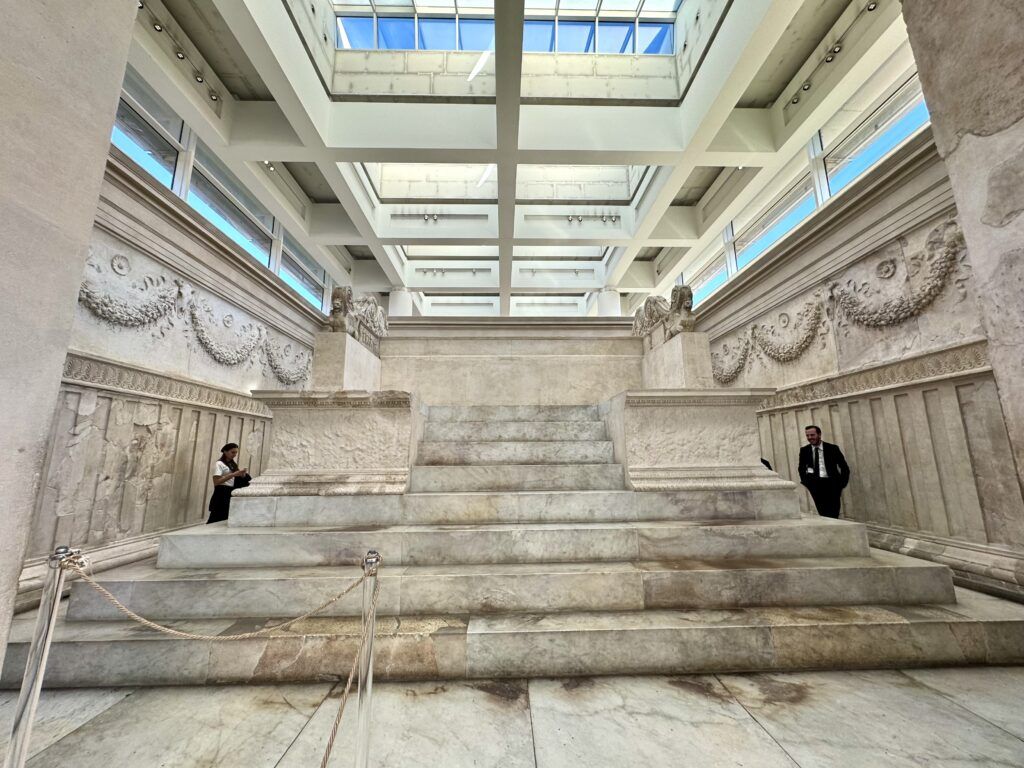
Sacrificial Altar
The Ara Pacis was a working altar.
The internal altar has two bases, with four steps up each one. At the top is the table where animals were sacrificed.
During a sacrifice, the Pontifex Maximus would enter the sanctuary, followed by the vestal Virgins, the flamines, and other priests.
Like the outer walls, the sacrificial table was once decorated with elaborate reliefs. But very little survived.
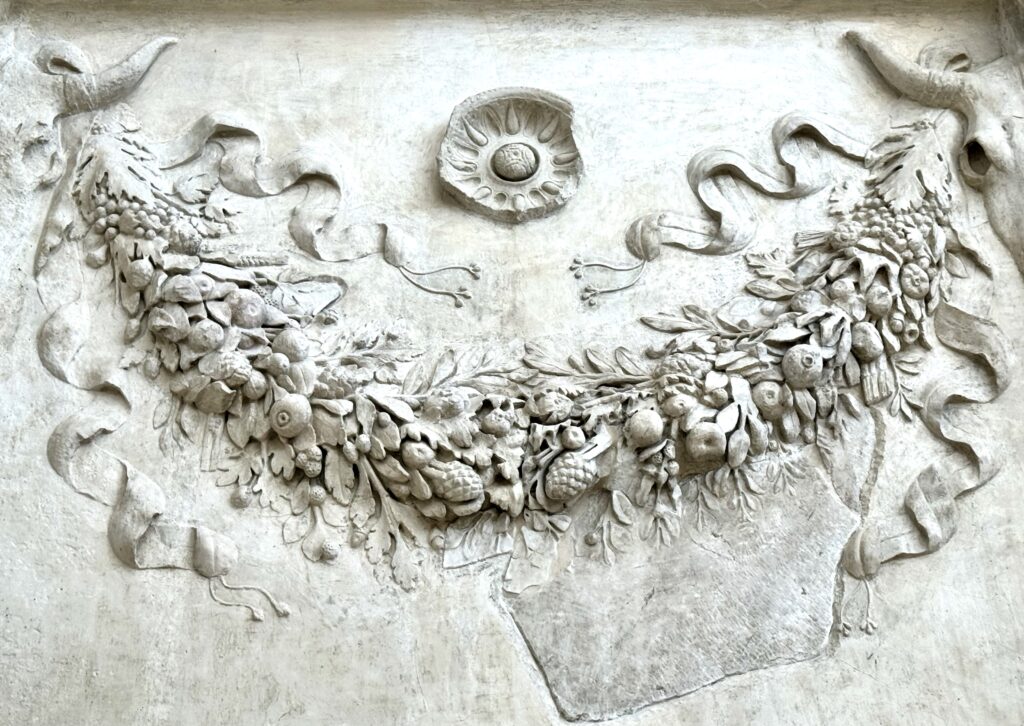
They do have the crowning slabs of the table. They’re decorated with winged lions and vegetal reliefs.
In the lower part, there is a scene of sacrifice, complete with vestel virgins and animals. Historians believe it might be the sacrifice celebrated on January 30 as decreed by the senate to honor Pax, the god of peace.
The surrounding walls were intentionally left plain due to the smoke and flames from the sacrifice. But there is a frieze of festoons hanging from ox skulls.
Look down to see the drain holes in the floor. These were used to wash out blood and fluids after the sacrifices.
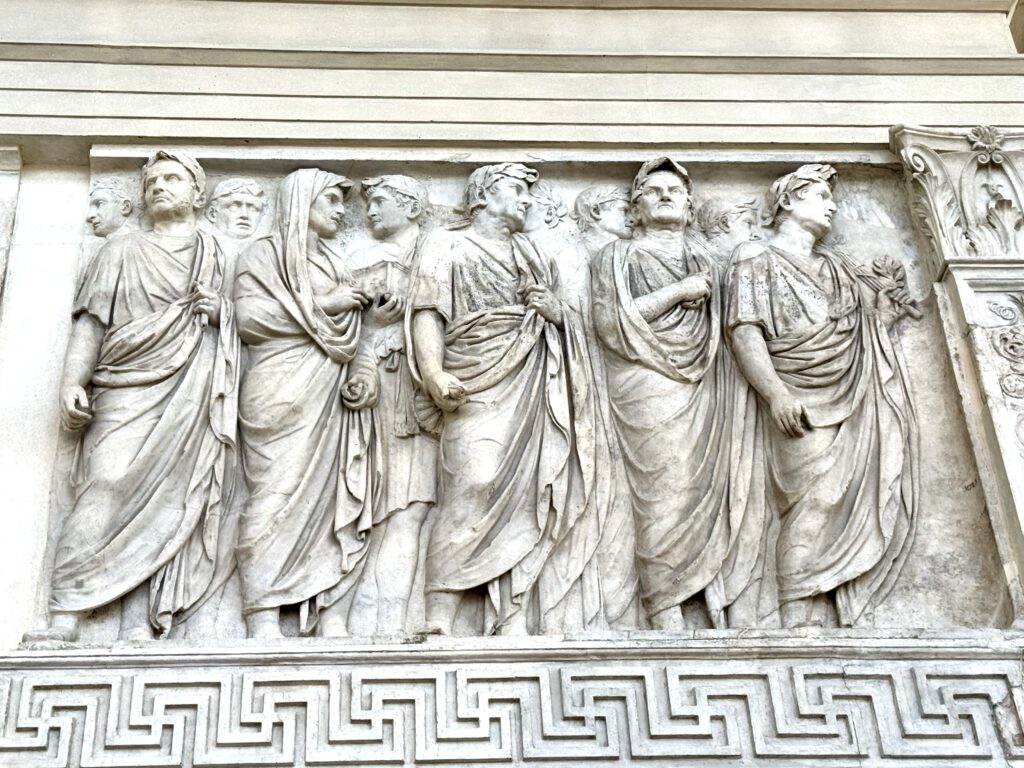
Processional Friezes
The most prominent and extensive decorations on the Ara Pacis are the two long processional friezes on the north and south walls.
These depict members of the imperial family and other dignitaries. They appear to participating in a sacred event. Historians theorize that it could be a religious procession, a procession for Augustus’ return from war, or a procession for the inauguration of the altar.
These are true portraits of actual Romans. Some are shown in high relief. Others, in the background, are in low relief. The contrast gives the precinct a sense of 3D space.
On the north wall, there’s a procession of senators. Each figure is wearing a toga and a laurel wreath on his head, symbolizing victory. On the south wall, you’ll see members of the imperial family, their servants, and children.
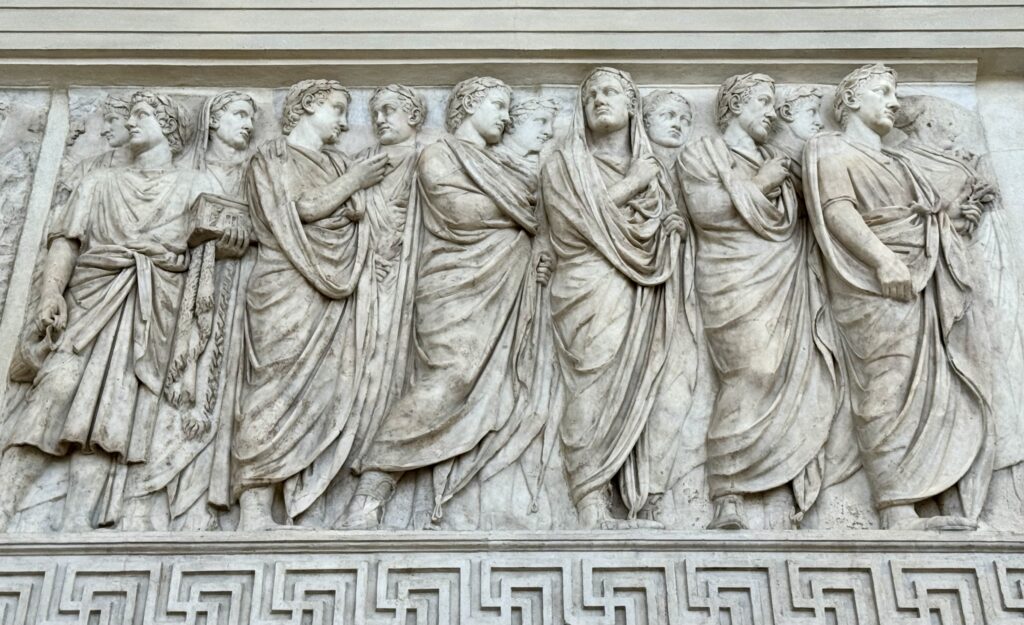
Notable figures include Augustus, his family, various senators, magistrates, and priests. You’ll even see a rare image of Nero as a young boy.
Scholars think they have identified the image of Augustus, though he is missing most of his body.
There is also an image of Agrippa, one of the emperor’s right hand man. He’s next to Augustus’ wife Livia, who wears a veil and garland.
The figures are portrayed in a highly idealized manner, signifying the importance and sanctity of the imperial family and the state.
Unfortunately, there’s not much signage to explain it all. But a panel in one corner indicates the names of all identifiable characters in the procession.
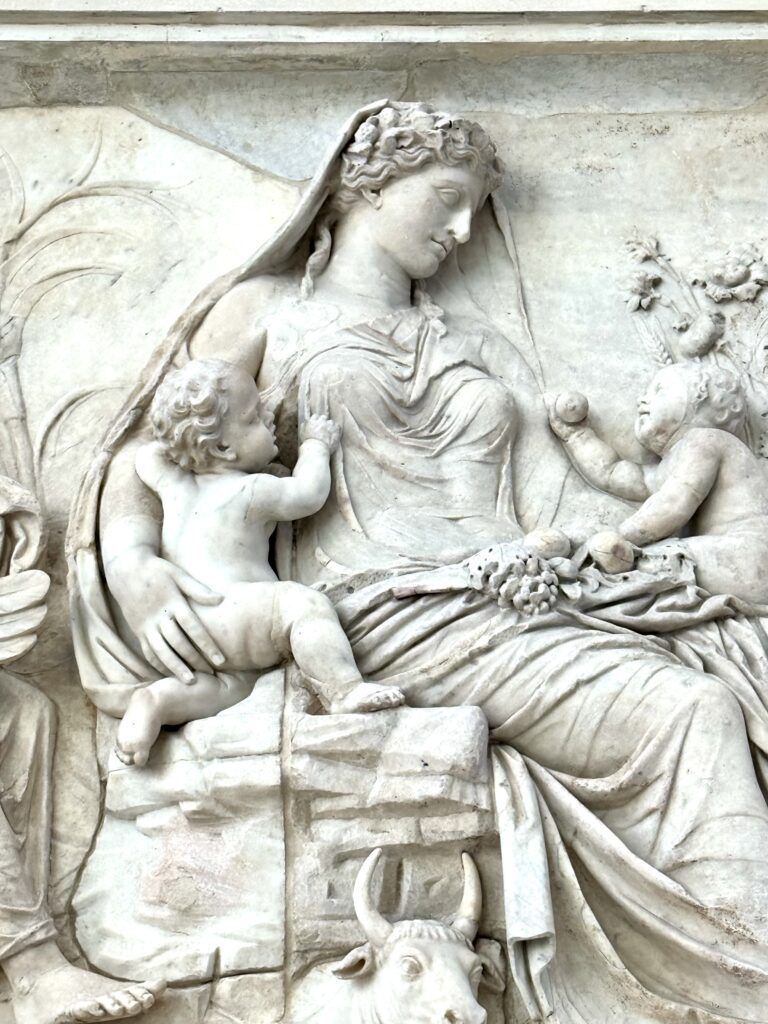
Tellus Panel
On the east side in the front of the altar is the Telles panel, which appears in remarkably good condition. It’s probably the most famous image from the Ara Pacis.
It features a female figure in the center with two babies. Scholars debate who is represented.
It could be a representation of Venus, Telles (Mother Earth), or Pax (Peace). In any event, she’s definitely a symbol of fertility and prosperity under Augustus.
The drapery on the figure is gorgeous and may remind you of the Partheon sculptures.
She’s flanked by mythological creatures, representing the abundance of the earth and sea. They almost look like they’re wrapped in halos.
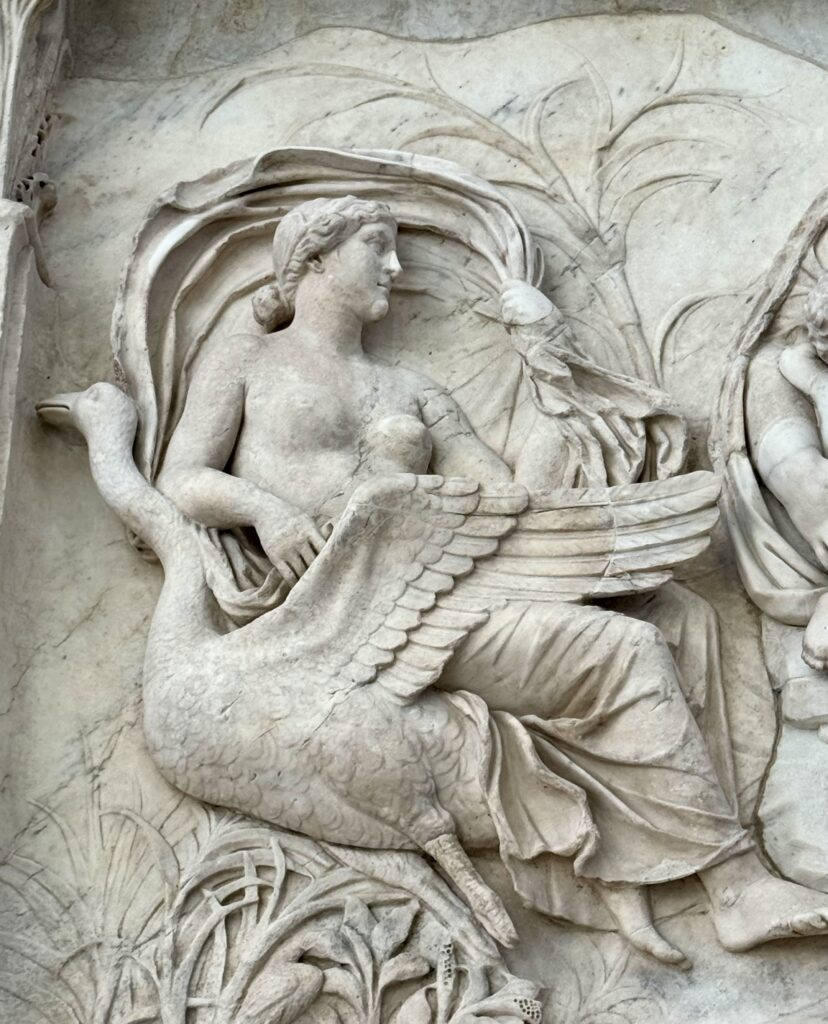
Aeneas Sacrificing Panel
This panel shows the Trojan hero Aeneas, the legendary founder of Rome, performing a sacred ritual.
He’s thought to be making a sacrifice to honor the gods and connect the cities of Troy and Rome, linking the ancient past to Augustus’s time.
In the carving, Aeneas appears as an older man on the right. He’s dressed as a priest and offering a sacrifice.
Although his right arm is missing, he likely held a ritual cup called a patera . Nearby, a young helper carries a tray with fruit and bread, and another brings a cow for the sacrifice.
The scene might represent a moment from Virgil’s Aeneid , where Aeneas, arriving in Italy, sacrifices to the goddess Juno. It’s a meaningful image, showing respect for the gods and connecting Rome to its heroic origins.
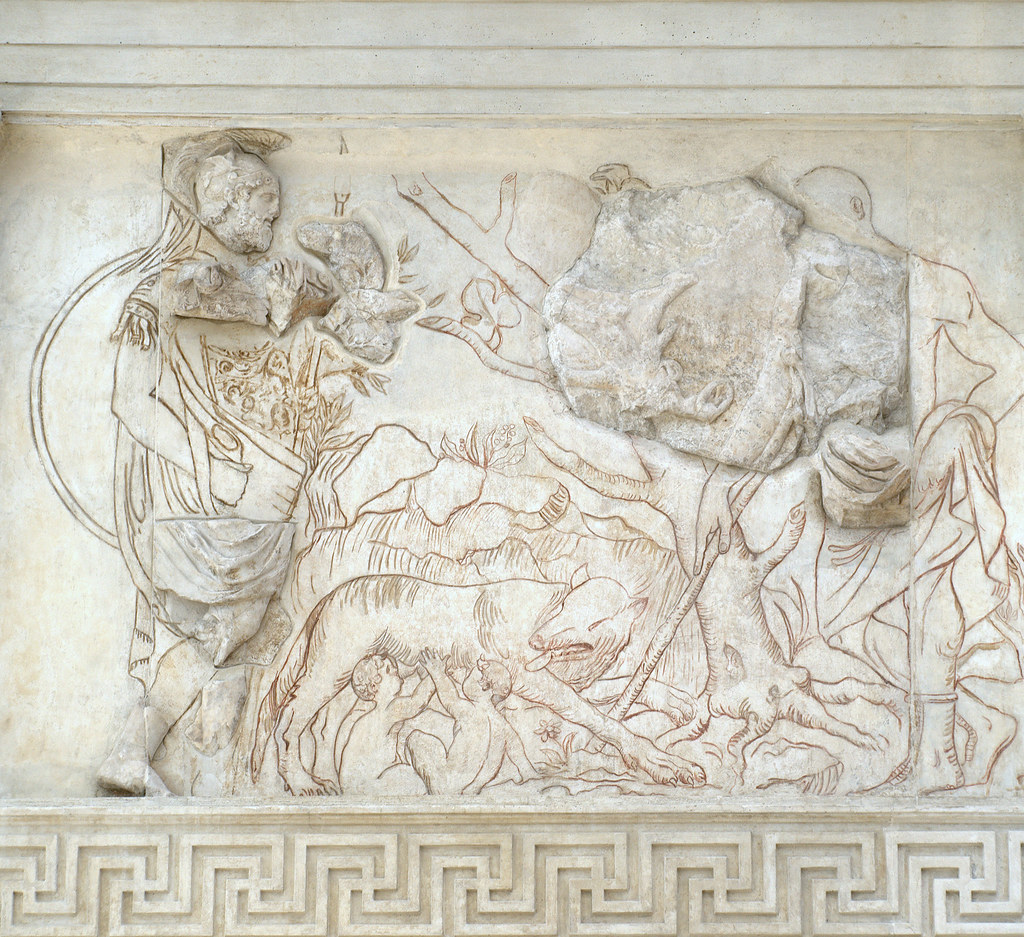
The Lupercal Panel
Another panel shows the She-Wolf suckling Romulus and Remus. it’s a devotional reference to the mythological origins of Ancient Rome .
The twins are framed by a fig tree and accompanied by a shepherd. You can see the talons of a bird.
On the left, the god Mars is depicted in military garb, including a crested helmet with a griffin.
His head is the most remarkable element of the panel. And it was almost lost to the monument. It was unearthed and sold to a private collector before the Italians realized it was part of the altar and repurchased it.
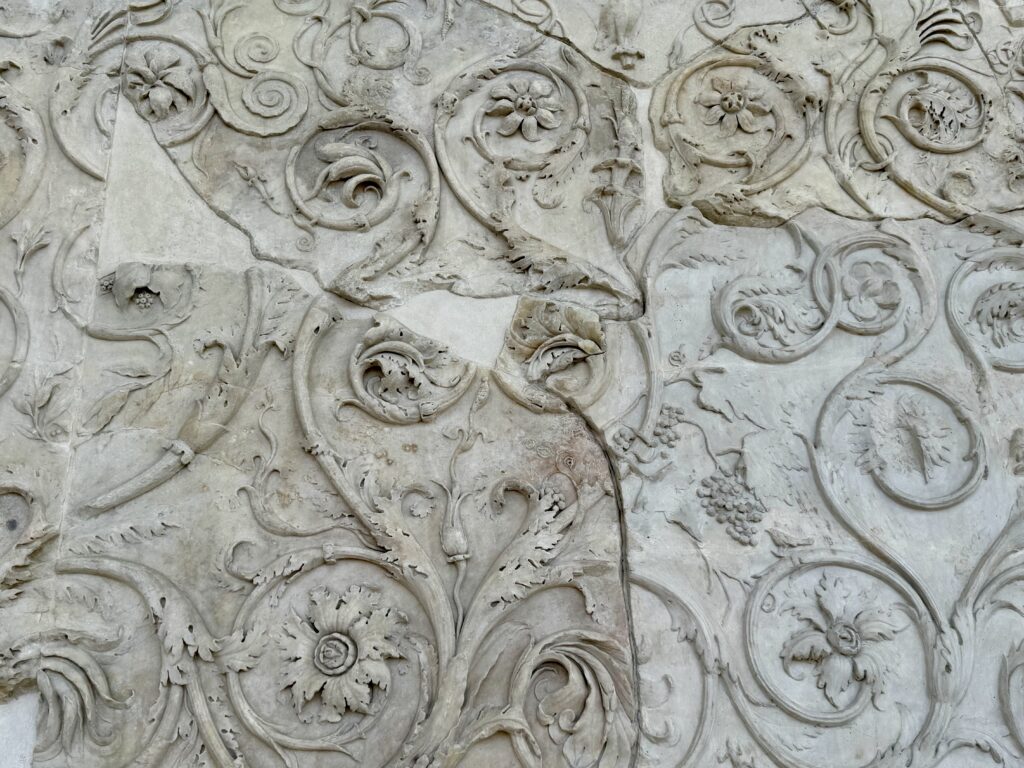
Floral and Vegetal Decorations
The lower friezes are one of the largest bas reliefs with vegetal scrolls ever carved in the classical world.
It’s a single expanding plant that springs from a the luxuriant tufts of a central acanthus plant. There are more than 50 different species of plants depicted.
There are animals forms nestling in there too — frogs, lizards, snails, birds, and swans.
Scholars believe the 20 swans refer to either Apollo or Venus. Or perhaps they represent both of the Augustinian patron-gods.
The decorations are meant to symbolize the fertility and abundance brought by the Pax Romana. Even nature is flourishing thanks to Augustus’ existence one earth.
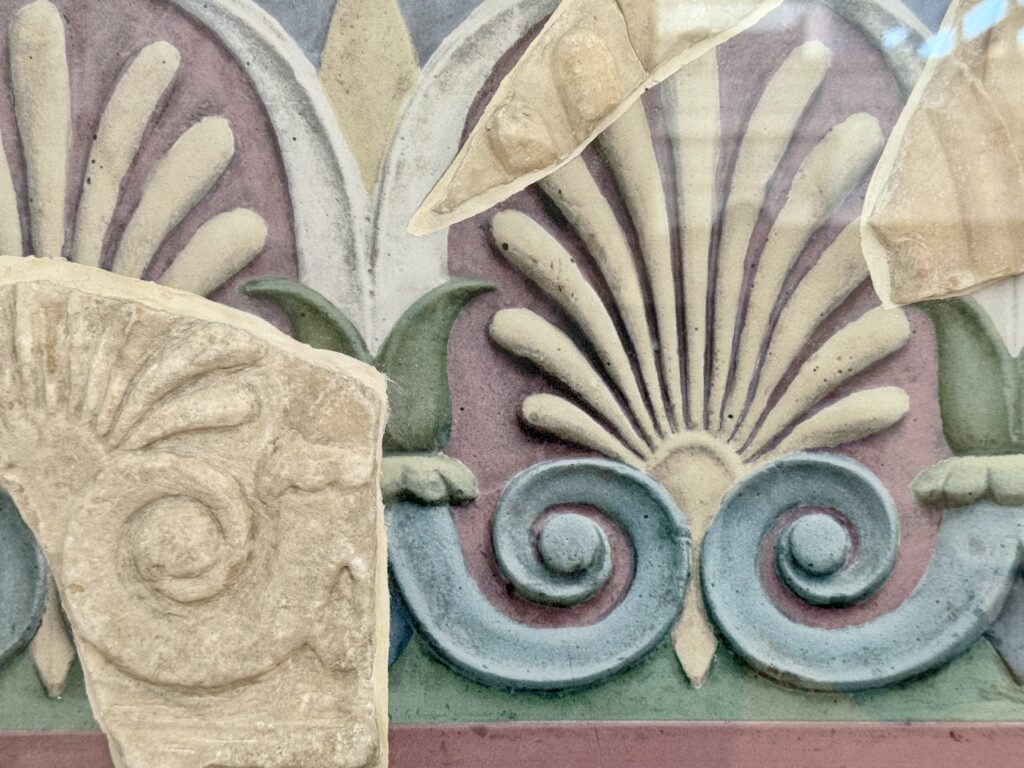
Practical Guide & Tips For Ara Pacis
Address : Lungotevere in Augusta
Hours : Open daily from 9:30 am to 7:30 pm. Last admission 6:30 pm.
Tickets :
€ 10.50. You can also get a large interactive iPad-like audio guide for € 6, which I highly advise getting to know what you’re looking. There’s not much signage.
The museum is also included in the Roma Pass .
I admit, the ticket is a bit pricey to see just one work of art. If you don’t want to pony up the money, you can get a pretty good look at the altar through the windows.
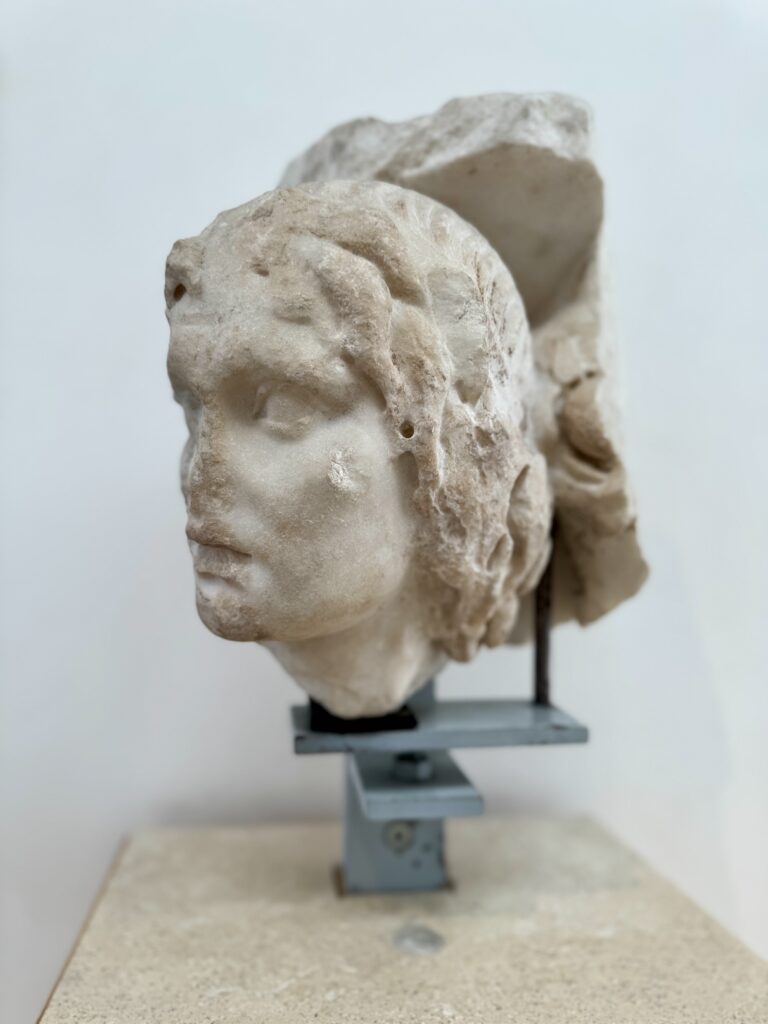
Is Ara Pacis Worth Visiting?
The Ara Pacis is a small museum. I think it’s well worth visiting, especially for lovers of Roman history. You could spend an hour or two here.
If you are not interested in Roman history, the museum may not be your cup of tea especially at its price point. It’s not a great place for kids.
There are benches to sit down on and contemplate the altar’s beauty. And the bookstore is fantastic!
In the museum’s basement, you’ll find educational materials about the excavation and restoration of the altar. There’s also a computer touch screen where visitor to can see a 3D reconstruction of the altar both in its present condition and with its probable ancient coloring.
Temporary exhibitions are also housed in the basement. You’ll need to pay a supplemental fee to see those.
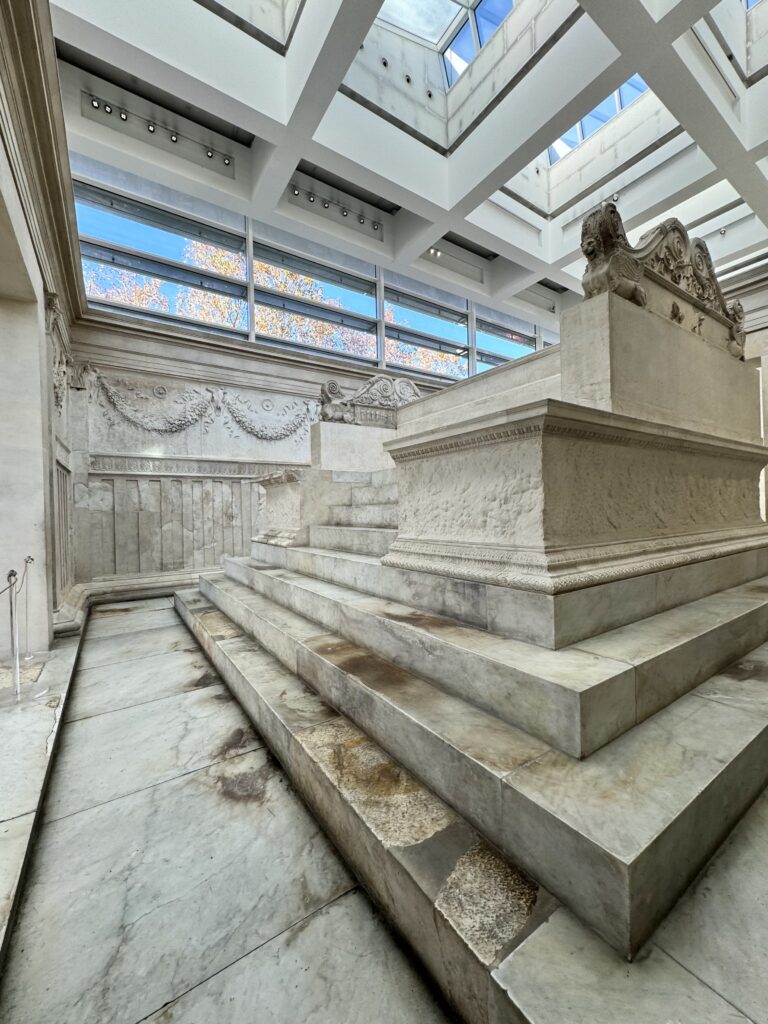
The Ara Pacis is right next to the Mausoleum of Augustus. It’s temporarily closed at the moment. Hopefully, it will reopen soon.
If you are obsessed with Augustus, I highly recommend visiting the House of Augustus on Palatine Hill. You can visit with a SUPER ticket or on a guided tour with a PhD .
I hope you’ve enjoyed my guide to visiting the Ara Pacis. You may enjoy these other Rome travel guides.
- 8 ways to spend 1 day in Rome
- 3 day itinerary for Rome
- 4 day itinerary for Rome
- 5 day itinerary for Rome
- Best museums in Rome
- Hidden gems in Rome
- Archaeological sites in Rome
- Guide to the Borghese Gallery
- Guide to Palatine Hill
- Guide to the Roman Forum
- Guide to the Colosseum
Pin it for later.
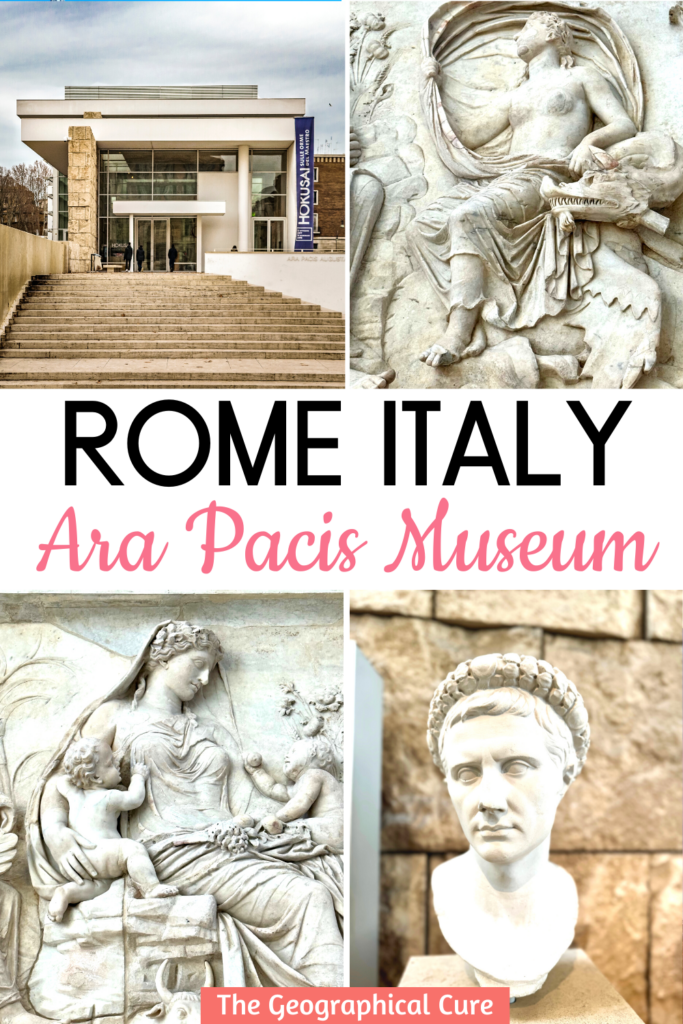
Leave a Comment Cancel reply
Save my name, email, and website in this browser for the next time I comment.
Last Updated on January 27, 2024 by Leslie Livingston
- Where to Stay
- Where to Eat
- Best Time to Visit Rome
- Top 10 Tips for Rome
- Bathrooms in Rome
- What to Pack & What to Wear
Money Matters
Getting Around
Getting to Rome
- Learn Italian
- Can You Travel to Rome Right Now?
- Italy Green Pass - do you need one?
- Rome Coronavirus News & Updates
- Rome & Vatican Tours
- Italy Tours
- Transfers & Transport
- Sign up & get a FREE ebook Subscribe Today!
- Romewise Home Page
- What to Do in Rome
Ara Pacis Augustae

By Warren George
November 9, 2023
You may have seen reference to the Ara Pacis when planning your Rome trip , but what exactly is it?
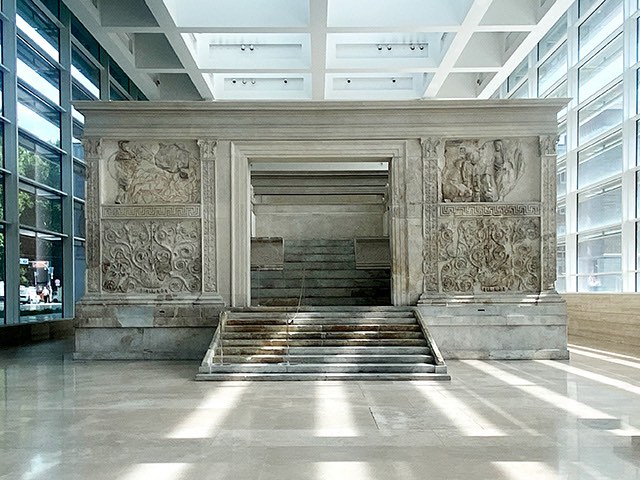
Keep reading to discover everything you need to know about one of Rome's most unique monuments ; the Ara Pacis Augustae.
Rome's Ara Pacis - Everything you need to know
Incredibly, the Ara Pacis dates back to the time of the first Roman emperor, Augustus .
This means that when you're standing in front of the reconstructed altar, you are looking at something that was a focal point of ancient Rome, which is pretty amazing!
Visiting the altar of Augustan peace tends to be quite low on most visitors list of must-sees , but I'm here to tell you that it is absolutely worth taking the time to visit.
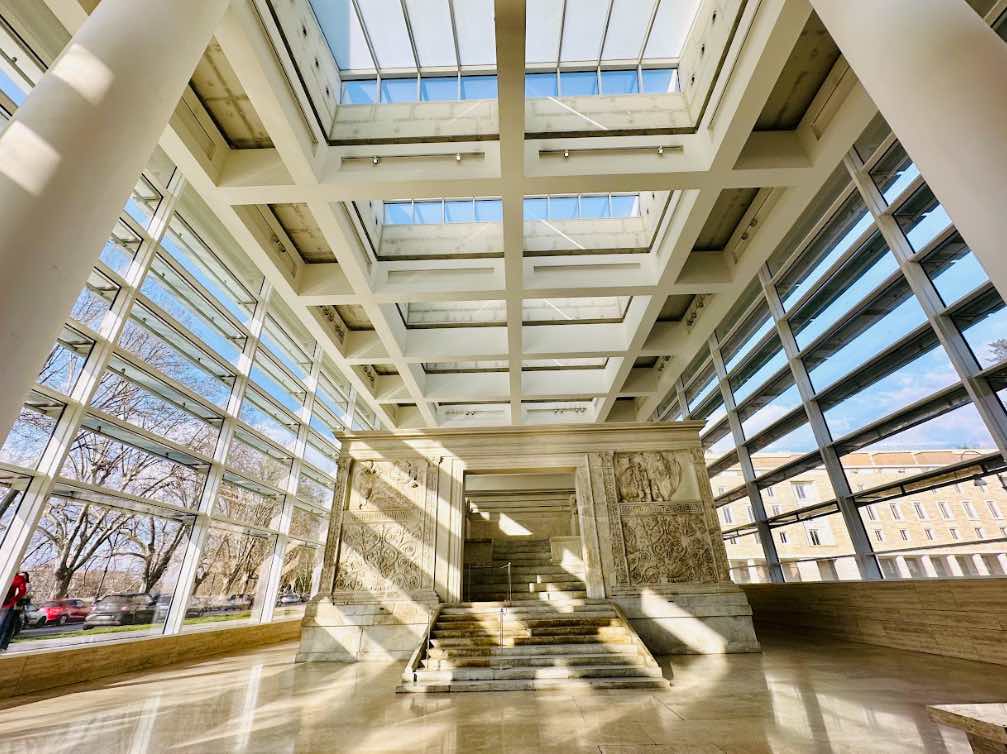
On this page we'll go over:
- What is the Rome Ara Pacis Augustae?
- Where is the Ara Pacis?
Why visit the Ara Pacis Augustae?
- The history of the Ara Pacis Augustae
- The construction of the Ara Pacis Augustae
The Ara Pacis Museum
- All about the Res Gestae Divi Augusti
What do the reliefs and sculptures on the Ara Pacis depict?
Where to eat and drink near the ara pacis, what is the ara pacis augustae.
The Ara Pacis Augustae, or Altar of Augustan Peace in Rome, is one of the most important and well-preserved examples of Roman art and architecture still surviving today.
The altar was built to celebrate the peace and prosperity brought to the Roman Empire during the reign of Emperor Augustus ( Pax Romana or Pax Augusta ) and is now a must-see when visiting Rome .
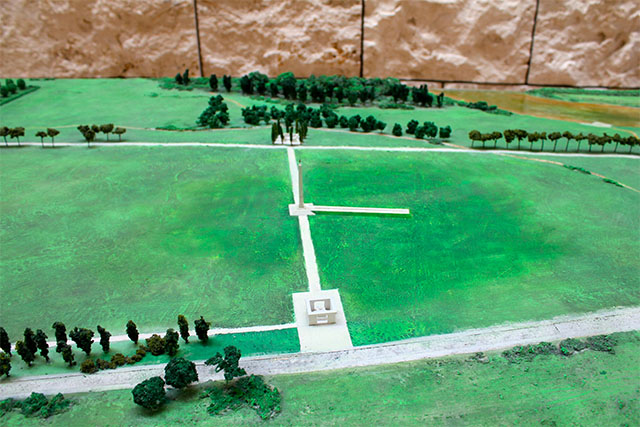
Where is the Ara Pacis Augustae?
Today, the Rome Ara Pacis is located at Lungotevere in Augusta, 00186 in Rome , adjacent to the Tiber river and Piazza Augusto Imperatore where the reconstructed altar is housed in a dedicated museum .
However, the Altar of Augustan Peace was originally located at the juncture (of the modern streets) of Via in Lucina and Via del Giardino Theodoli .
Keep reading to find out why the location of this monument is now different compared to ancient times!
The Ara Pacis is one of the key Augustan monuments from the ancient city and a preeminent example of Roman sculpture.
It represents a period in ancient Roman history that shaped the future of the Roman empire, and by extension the western world.
The Ara Pacis Augustae is also relevant to Rome and Italy's modern history; its reconstruction and placement in its current location was sponsored by Benito Mussolini and his regime in the 1930s.
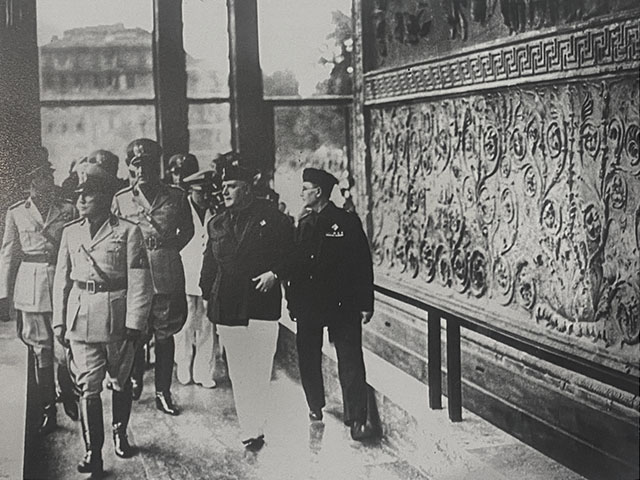
Mussolini was attempting to capture some of ancient Rome's, and specifically, Augustus' past glory by associating himself with the Altar of Augustan Peace.
In my opinion no other monument in Rome encapsulates such a span of history.
Life of Emperor Augustus

Want to learn more about the life of Rome's first emperor, Octavian Augustus?
John Williams' book " Augustus " is a fictional recounting of Augustus' life from the moment he heard of his uncle Julius Caesar's assassination in 44 BCE.
The book tells the story through imagined epistles and it's a fantastic and easy way to absorb the history of this pivotal moment in Rome's history.
Disclosure : If you make a purchase through a link on this page, I may receive a small commission - at no extra cost to you. Thank you for supporting my site!
History of the Ara Pacis Augustae
Construction of the Altar of Augustan Peace began in 13 BCE and it was inaugurated in 9 BCE.
It was commissioned by the Roman Senate to honor Augustus' return from Hispania and Gaul (modern day Spain and Portugal, and France and Belgium respectively), where he had consolidated the control and influence of the Roman empire.
The altar was created to be an embodiment of the Pax Romana (Roman Peace), a period of relative stability and prosperity for ancient Rome.
After its completion the Rome Ara Pacis stood in the Campus Martius, an open space in the city used for public gatherings and military training.
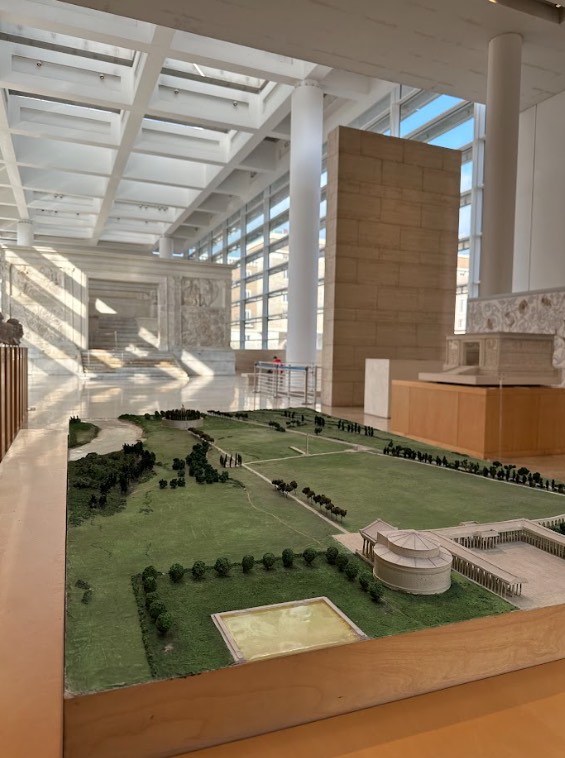
During the Middle Ages, it was buried under sediment following floods of the river Tiber and gradually forgotten.
It was rediscovered in the 16th century and subsequently excavated in more recent times.
During the early 20th century the Ara Pacis Pavilion was constructed to house the reconstructed altar.
In order to protect the altar for future generations the Ara Pacis museum was built.
Designed by the American architect Richard Meier, the museum opened in 2006.
The modern structure features glass walls and a minimalist design that contrasts with the ancient marble altar, creating a unique juxtaposition of ancient and contemporary architecture.
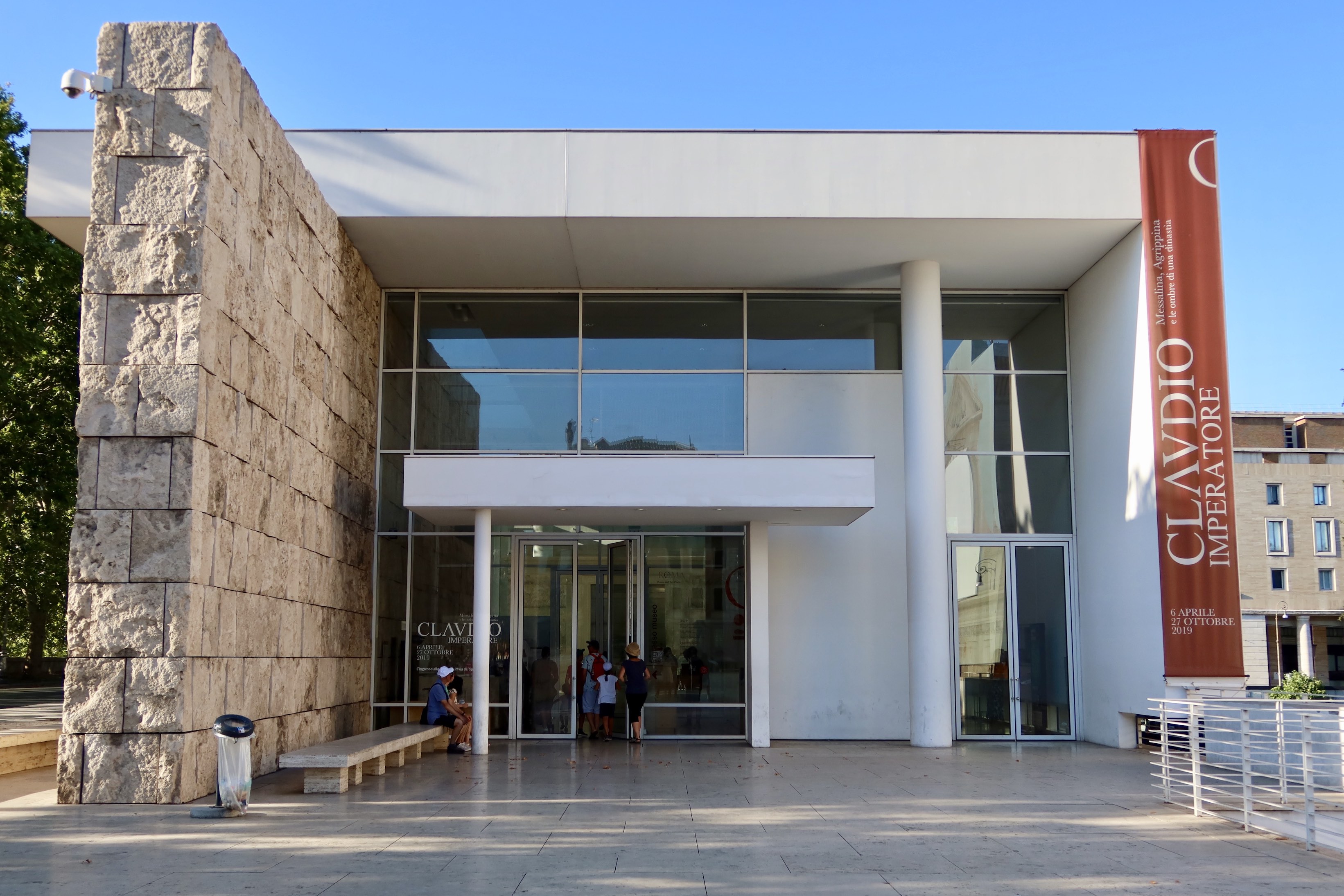
Today, the Ara Pacis museum attracts visitors who come to admire the intricate ancient Roman relief sculpture and learn about its historical and artistic significance.
The Ara Pacis stands as a testament to the artistic achievements of ancient Rome and serves as a tangible symbol of the Augustan era and the Pax Romana.
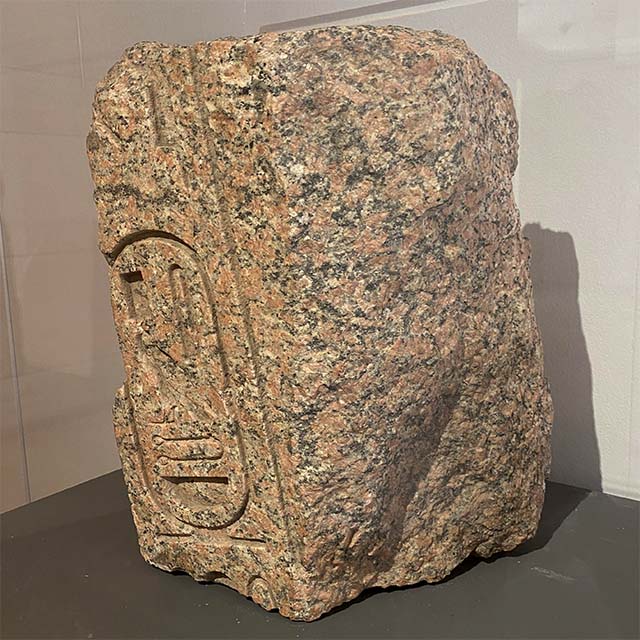
About the construction of the Ara Pacis Augustae
The location chosen for the Ara Pacis Augustae was the Campus Martius, a public space in Rome traditionally associated with the military and government functions.
The altar itself is made of white Carrara marble and adorned with intricate reliefs.
The reliefs depicted various scenes and figures associated including members of the imperial family, figures from the Roman religion, and allegorical representations of Rome and its virtues.

The reliefs were carved by a team of skilled sculptors.
The level of detail and craftsmanship exhibited in the reliefs is some of the best surviving evidence of the artistic skill and technical expertise of the Roman artisans of the time.
The rectangular structure surrounding the altar, known as 'the precinct', was built to enclose and protect the Ara Pacis, the altar itself.
Today, the Ara Pacis Augustae stands as an important archaeological and invaluable example of early Roman imperial art.
It is housed in the Ara Pacis museum (more about this below!), where you can admire the monument in its reconstructed state with its beautifully preserved reliefs.
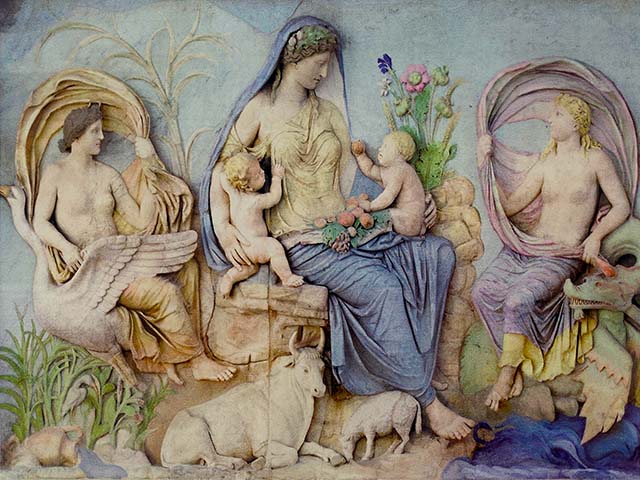
Following a series of excavations and discoveries in the 19th and 20th century where the Ara Pacis emerged piece by piece, it was agreed that the monument should be reconstructed.
It was also agreed that a structure would be created to house the Ara Pacis, protecting it from the elements and in honor of its importance in the history of Rome.
The 'Ara Pacis Pavillion' was inaugurated on September 23 (Augustus' birthday) 1938 by Benito Mussolini at Lungotevere in Augusta .
The new (and current) location was chosen away from its original position for two reasons:
- The original location at the juncture of Via in Lucina and Via del Giardino Theodoli was, and still is, a densely developed area with historically significant palaces.
- Mussolini's regime believed that the Ara Pacis Augustae should take pride of place next to the newly-developed Piazza Augusto Imperatore and the Mausoleum of Augustus .

The Altar of Augustan Peace continues to reside at the same location, but now in a more modern building opened in 2006, designed by architect Richard Meier as a replacement for the ageing fascist-era pavilion.
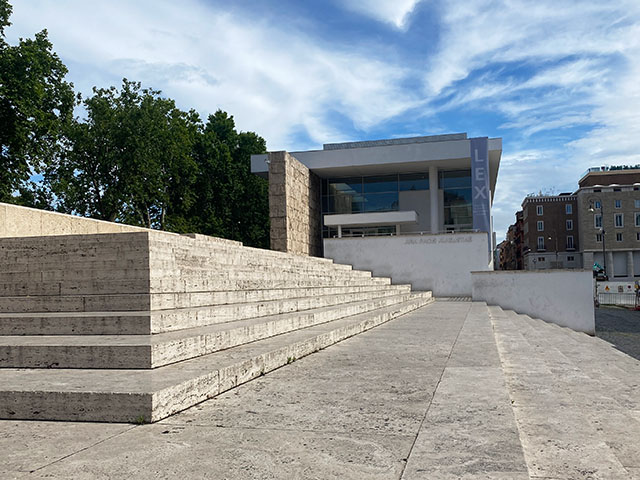
About the Res Gestae Divi Augusti
Outside the Ara Pacis museum you will find a reconstruction of the Res Gestae Divi Augusti, which was created at the same time as the Ara Pacis Pavilion.
The Res Gestae Divi Augustus, meaning 'the achievements of the divine Augustus', was an account of Augustus' reign, written by himself.
In this ancient autobiography Augustus advertises his successes to the Roman populace.
Augustus pioneered the use of propaganda and the Res Gestae Divi Augusti was immortalised in monuments across the Roman empire where they reminded everyone of Augustus and the Augustan Peace.
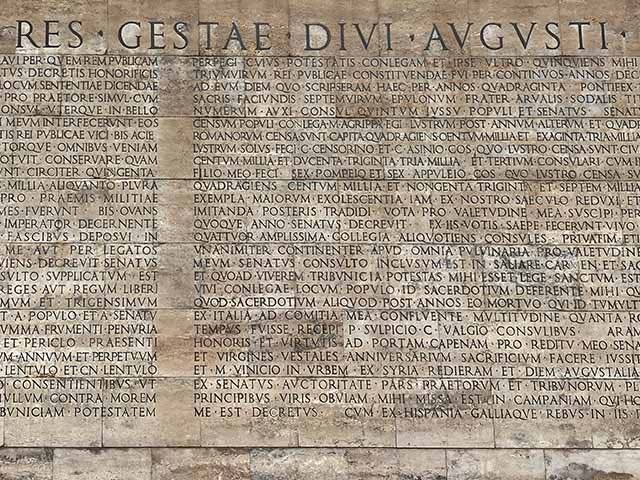
Visiting the Ara Pacis Museum
The Ara Pacis museum is part of the 'Musei in Comune' organisation that manages most of Rome's most significant museums, including the Capitoline Museums and Palazzo Massimo alle Terme (Museo Nazionale) .
For the latest ticket pricing information and visiting hours refer to the official website .
The museum routinely features special exhibitions in the space under the Ara Pacis precinct and altar.
Note that typically there is an extra charge to visit the museum when there is a special exhibit running.
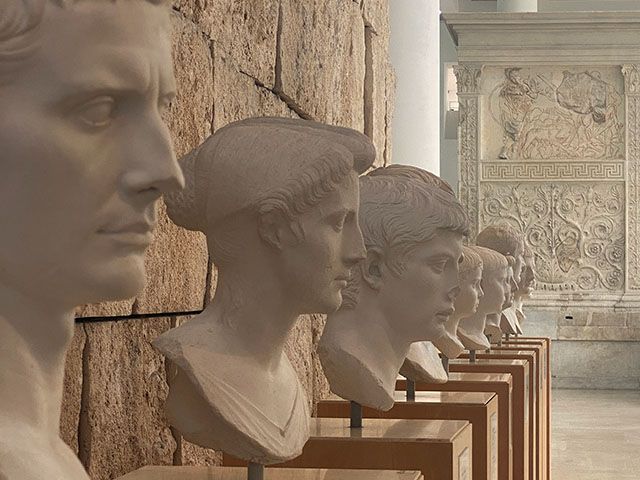
You should allow between one and two hours to visit the Ara Pacis museum and any special exhibitions.
On site you will find a well-stocked gift and bookshop and bathrooms .
Note that there is no bar/cafe or restaurant on site, for recommendations on where to eat and drink nearby, keep reading!
The Ara Pacis museum is accessible to anyone with mobility challenges via ramps located outside the main entrance.
Once inside you will find the Ara Pacis Augustae itself on the ground level, just inside the museum entrance.
The bathrooms are on this same level, at the back of the museum.
Richard Meier deliberately designed his building to enable everyone to enjoy the beauty of the Ara Pacis.
So if you're pressed for time or traveling to Rome on a budget you can see the Ara Pacis for free from the outside.
Simply walk along the glass wall on the Lungotevere and peer in!
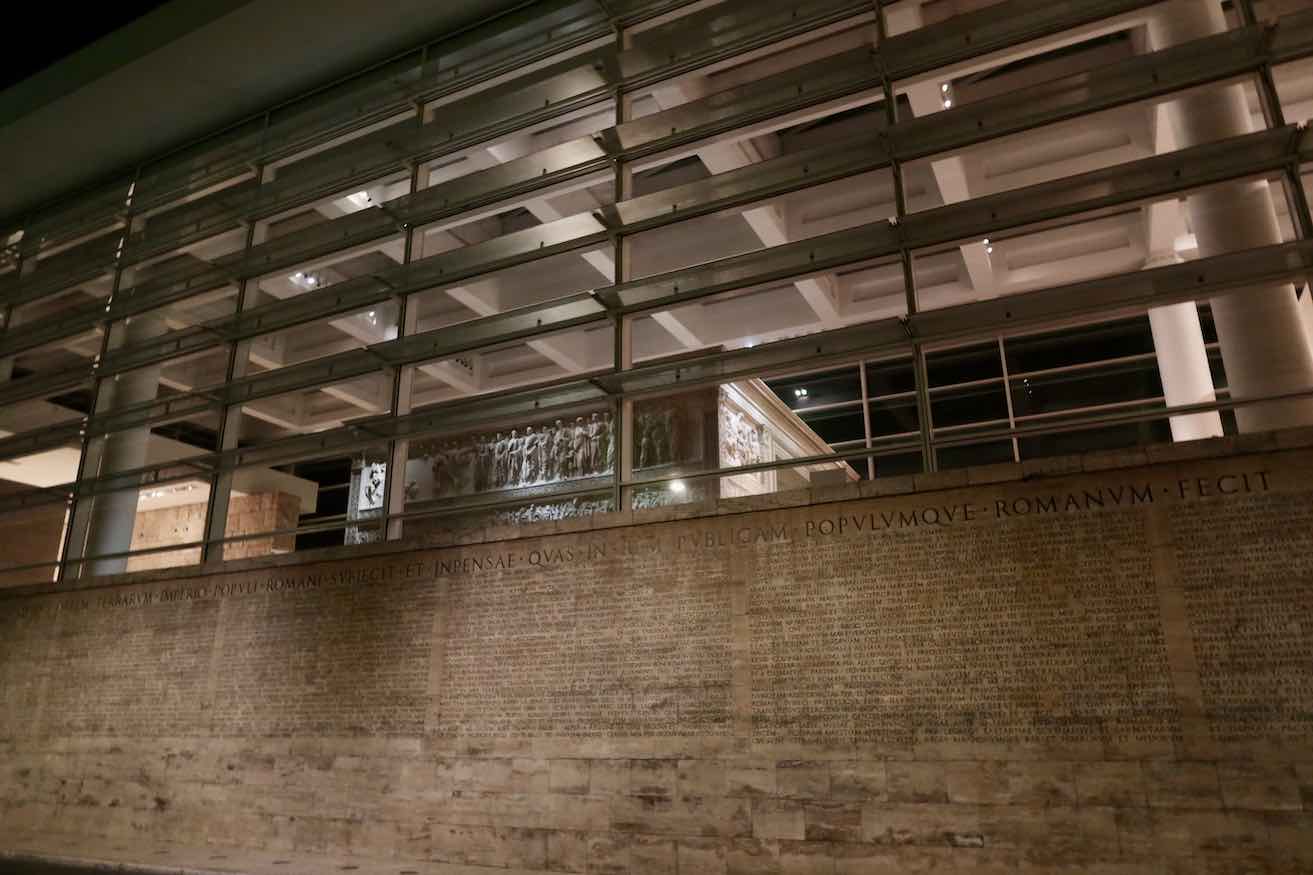
The perfect 3-day itinerary in Rome
Trying to figure out how to organize your visit to Rome? I've got the perfect 3-day itinerary for first-time visitors (or those who have not been here in a while.) It works for a 2.5 day visit as well.
In my 3-day itinerary, you'll see all the major must-see Rome attractions like the Vatican , Colosseum , Trevi Fountain , Pantheon , Piazza Navona , Spanish Steps , Castel Sant'Angelo , and much more.
And if you have more time, or want suggestions for extra/other things to do, you'll find that there too.
Visit my page with the best 3-day itinerary in Rome for first-timers .
Let's examine what each part of this ancient Roman treasure represents:
The West Wall
This is the first side of the Altar of Augustan Peace that you see when entering the Ara Pacis museum .
Referring to the top right panel, you will see a scene that is generally considered to depict the famous Trojan Aeneas sacrificing a sow to the Penates, the household gods of the Trojans.
Aeneas is a key figure in the foundation of Rome, and Emperor Augustus claimed direct descendancy from him.
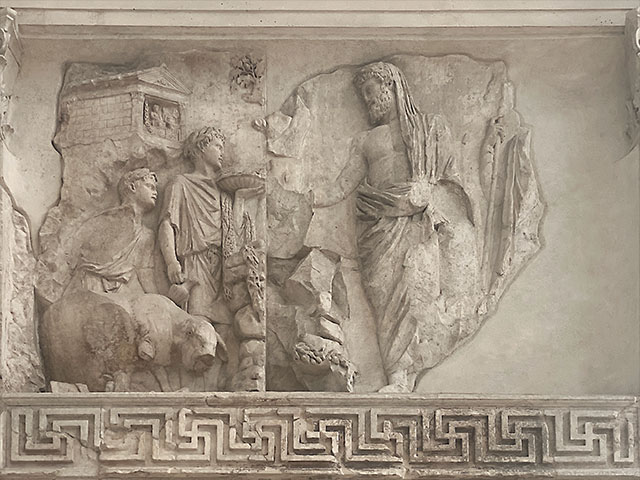
On the opposite, left side top, the few surviving fragments have been recognised as showing other key figures in Rome's history: Romulus and Remus, the famous twins credited with the city's founding .
The 'Panel of the Lupercal' likely depicted a traditional scene of the twins suckling at the she-wolf, with the god Mars (their creator) and their adopted father Faustulus.
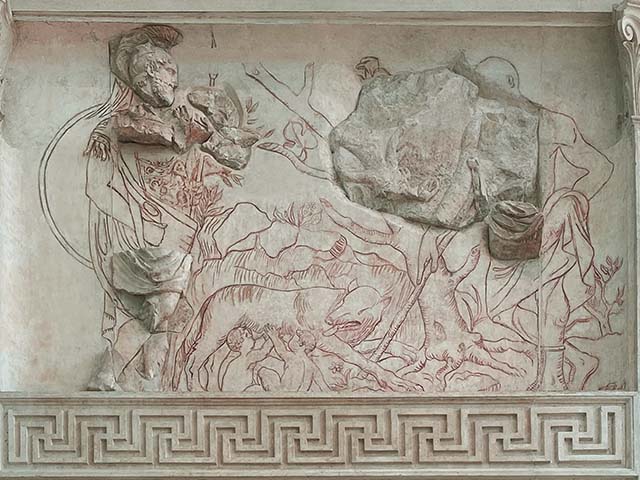
Beneath both of these panels, and running around the entirety of the lower half of the precinct you will see the 'Great Vegetal Frieze'.
When looking at this consider originally that it would have been painted (as would have the whole monument) in vivid colors to mimic nature.
The frieze features a range of plants, all perfectly arranged in symmetry, as well as several animals and insects from the Roman world.
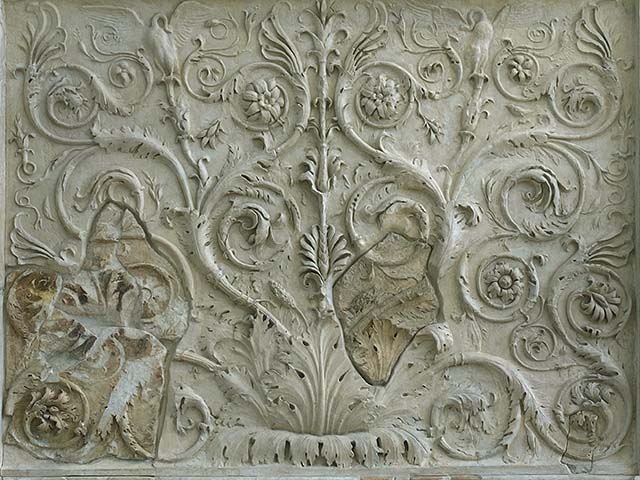
The North Wall
Moving clockwise as you face the west wall, you will find the north processional frieze stretching the length of the Altar of Augustan Peace.
This scene, along with the corresponding representation on the south side (more about this below) are believed to show one continuous procession.
This side begins with members of Augustus' family before transitioning to show priests from the Roman state religion and government officials.
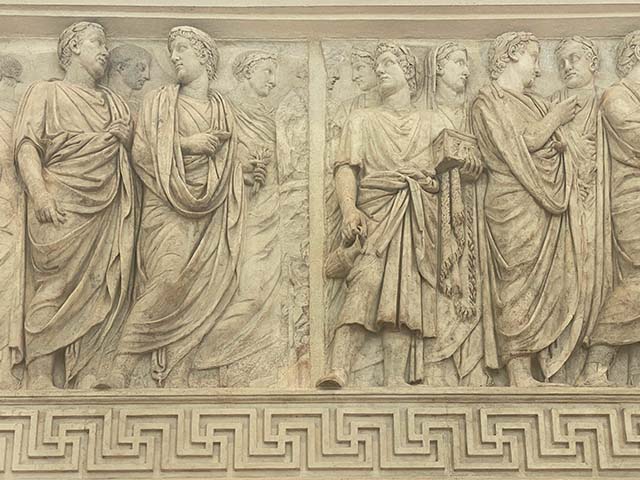
The East Wall
Moving to the 'back' of the Ara Pacis Augustae, you will find in the top left panel possibly the best known relief from the monument.
This frieze shows a Roman goddess, who exactly it is is subject to debate still however.
Theories propose that it could be Tellus (mother earth) or Venus, the divine mother of Aeneas and from whom emperor Augustus claimed he was descendant.
The goddess is at the center of a familial scene, where she holds two young boys, possibly Augustus's heirs.
She is then flanked by two other women who are believed to represent Augustus' daughter Julia and his wife Livia.
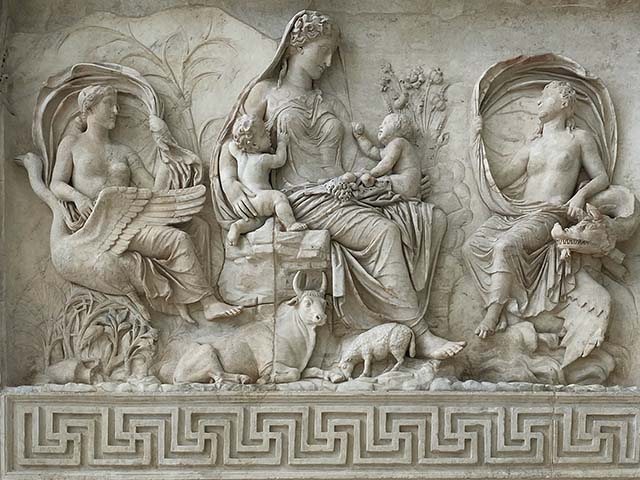
On the opposite, right hand top panel you will see a largely-incomplete panel that displayed the goddess Roma.
This was ascertained during the early 20th century when the two small fragments now here were discovered.
The first featured part of a shield, the second elements of a seated female figure.
Only six years later was it recognised that these belonged to the same relief, and therefore based on other known examples, the overall figure was determined to be the goddess Roma.
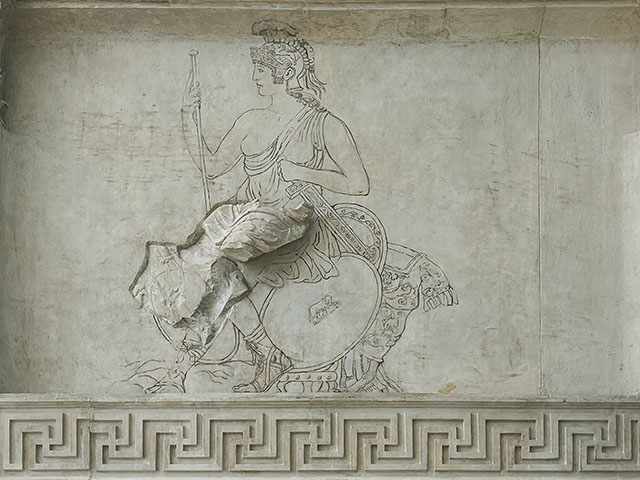
The South Wall
Continuing clockwise around the Altar of Augustan Peace you will return to the processional scene that started on the north side.
At approximately one third along this scene (moving left to right), Augustus himself is visible.
Unfortunately his figure is incomplete, but instantly recognisable where he is wearing a laurel wreath and his surrounded by his 'lictor' bodyguards.
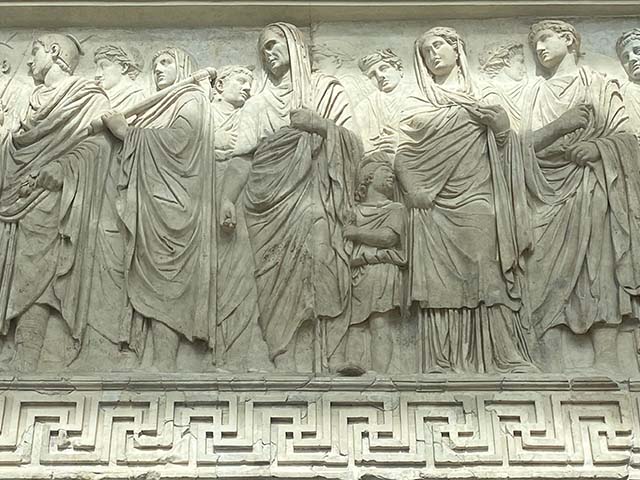
Moving further left and beyond Augustus, you can see senior figures from the Roman state religion; priests and augurs.
The final section of this scene is dominated by members of the imperial household including Marcus Agrippa, August's right-hand man, recognized by his hooded head and Augustus-facing glance.
Ready to plan your trip?
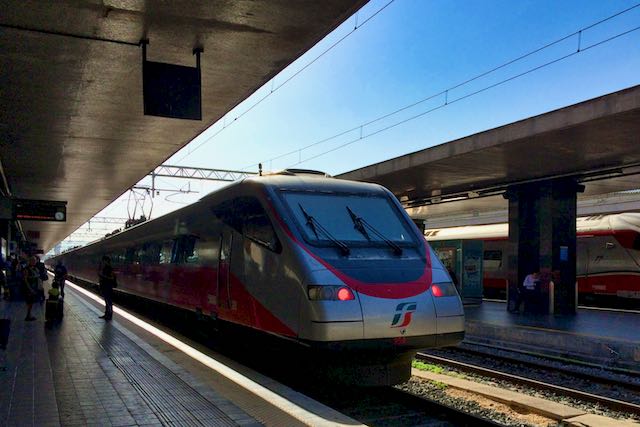
If you are looking for a unique and secluded spot where you can take a break , and enjoy a unique view of the Ara Pacis museum and Mausoleum of Augustus, head to the terrace of the Bulgari Hotel at Piazza Augusto Imperatore.
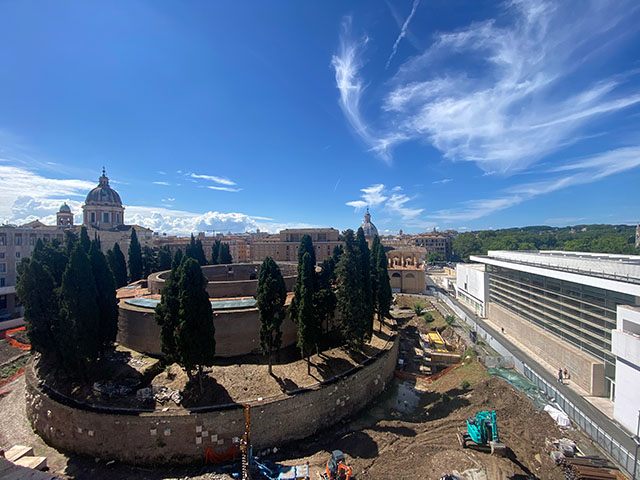
The Ara Pacis is located not far from Piazza del Popolo where you will find a number of great spots to eat and drink.
Here are two of my favorites:
- Rosati - Here was where Federico Fellini, the famous Italian director would sit and scout for extras to be in his films. When someone passed by that fit his requirements, he would shout out and ask them to join him for a coffee ! Soak up his heritage with a hot drink or aperitivo.
- Dal Bolognese Roma - Experience traditional Roman dining and cuisine in this institution of a restaurant, right next door to Rosati and with incredible views of Piazza del Popolo.
Get your 100% free Rome trip planner now!
Simply sign-up today for our free newsletter and get the Romewise Quick Start guide to Rome:
We are committed to respecting your data. Click for our Privacy Policy .
Comments? Questions? Suggestions?
Please come over to the private Romewise Facebook group and join in the conversation.
You will often find me there, happy to answer your questions / comments!
You will also meet other Rome lovers and experts, too.
What are you waiting for?
Come join in the fun !

Read here about our sponsorship policy
Top attractions and tours

- Colosseum - Don't miss visiting Rome's most iconic monument
- Vatican Museums - This is where the Sistine Chapel is
- Pantheon - Book ahead and skip the line
- Galleria Borghese - You'll need to book ahead for one of Rome's best museums
- Castel Sant'Angelo - See Rome's history through its architecture
- Rome City Pass - A great way to make your Rome visits easier
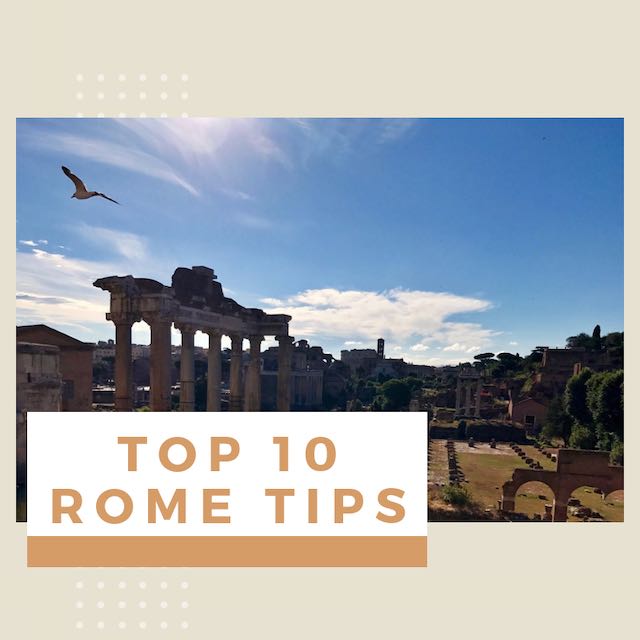
New to Romewise? Start Here
Get the most out of Romewise

Coming To Rome?
Weather in Rome
Accommodation
Already in Rome?
Things to Do
Home | About Me | Privacy Policy | Legal Disclaimer | Affiliate Disclosure | Contact Me
Copyright © 2009-2024 by Elyssa Bernard, Romewise.com | All Rights Reserved.
Ara Pacis Augustae
Ara Pacis Augustae (Altar of Augustan Peace), 9 B.C.E. (Ara Pacis Museum, Rome, Italy)
Ara Pacis Augustae (Altar of Augustan Peace), 9 B.C.E. (Ara Pacis Museum, Rome, Italy) (photo: Steven Zucker , CC BY-NC-SA 2.0)
The Roman state religion in microcosm
Portrait of Augustus as Pontifex Maximus from the Via Labicana, after 12 B.C.E. (Palazzo Massimo alle Terme, Rome)
Vowed on July 4, 13 B.C.E., and dedicated on January 30, 9 B.C.E., the monument stood proudly in the Campus Martius in Rome (a level area between several of Rome’s hills and the Tiber River). It was adjacent to architectural complexes that cultivated and proudly displayed messages about the power, legitimacy, and suitability of their patron—the emperor Augustus. Now excavated, restored, and reassembled in a sleek modern pavilion designed by architect Richard Meier (2006), the Ara Pacis continues to inspire and challenge us as we think about ancient Rome.
An open-air altar for sacrifice
Illustration showing the likely original placement of the Ara Pacis Augustae (far right) in proximity to the Horologium Augusti (sundial) and the Mausoleum of Augustus in the background. ( source )
The significance of the topographical placement would have been quite evident to ancient Romans. This complex of Augustan monuments made a clear statement about Augustus’ physical transformation of Rome’s urban landscape. The dedication to a rather abstract notion of peace ( pax ) is significant in that Augustus advertises the fact that he has restored peace to the Roman state after a long period of internal and external turmoil.
The Outer screen—processional scenes
Processional scene (south side), Ara Pacis Augustae (Altar of Augustan Peace) 9 B.C.E. (Ara Pacis Museum, Rome) (photo: Steven Zucker , CC BY-NC-SA 2.0)
A member of the Priestly college (association) of Septemviri epulones, carries an incense box, processional scene (north side), Ara Pacis Augustae (Altar of Augustan Peace) 9 B.C.E. (Ara Pacis Museum, Rome) (photo: Steven Zucker , CC BY-NC-SA 2.0)
Augustus (far left) and members of the imperial household, Ara Pacis Augustae (Altar of Augustan Peace) 9 B.C.E. (Ara Pacis Museum, Rome) ( source )
Processional scene (south side) with Agrippa (hooded), Ara Pacis Augustae (Altar of Augustan Peace) 9 B.C.E. (Ara Pacis Museum, Rome) (photo: Steven Zucker , CC BY-NC-SA 2.0)
Mythological panels
- a scene of a bearded male making sacrifice (below)
- a scene of seated female goddess amid the fertility of Italy (also below)
- a fragmentary scene with Romulus and Remus in the Lupercal grotto (where these two mythic founders of Rome were suckled by a she-wolf)
- and a fragmentary panel showing Roma (the personification of Rome) as a seated goddess.
Sacrifice Panel, Ara Pacis Augustae (Altar of Augustan Peace) 9 B.C.E. (Ara Pacis Museum, Rome) (photo: Steven Zucker , CC BY-NC-SA 2.0)
Tellus (or Pax) Panel, Ara Pacis Augustae (Altar of Augustan Peace) 9 B.C.E. (Ara Pacis Museum, Rome) (photo: Steven Zucker , CC BY-NC-SA 2.0)
View to the altar, Ara Pacis Augustae (Altar of Augustan Peace) 9 B.C.E. (Ara Pacis Museum, Rome) (photo: Steven Zucker , CC BY-NC-SA 2.0)
Implications and interpretation
Rediscovery, mussolini and augustus.
Vittorio Ballio Morpurgo, Ara Pacis Pavillion, 1938 (photo: Indeciso42 CC BY-SA 4.0)
The Ara Pacis and Richard Meier
Richard Meier and Partners, Ara Pacis Museum, Rome, 2006
The firm of architect Richard Meier was engaged to design and execute a new and improved pavilion to house the Ara Pacis and to integrate the altar with a planned pedestrian area surrounding the adjacent Mausoleum of Augustus.
Enduring monumentality
The Ara Pacis Augustae continues both to engage us and to incite controversy. As a monument that is the product of a carefully constructed ideological program, it is highly charged with socio-cultural energy that speaks to us about the ordering of the Roman world and its society—the very Roman universe.
Augustus had a strong interest in reshaping the Roman world (with him as its sole leader) but he had to be cautious about how radical those changes seemed to the Roman populace. While he defeated enemies, both foreign and domestic, he was concerned about being perceived as too authoritarian–he did not wish to be labeled as a king ( rex ) for fear that this would be too much for the Roman people to accept. So, the Augustan scheme involved a declaration that Rome’s republican government had been “restored” by Augustus and he styled himself as the leading citizen of the republic ( princeps ). These political and ideological motives then influence and guide the creation of his program of monumental art and architecture. These monumental forms, of which the Ara Pacis is a prime example, served to both create and reinforce these Augustan messages.
The story of the Ara Pacis becomes even more complicated since it is an artifact that then was placed in the service of ideas in the modern age. This results in its identity becoming a hybridized mixture of Classicism, Fascism, and modernism—all difficult to interpret in a postmodern reality. It is important to remember that the sculptural reliefs were created in the first place to be easily legible so that the viewer could understand the messages of Augustus and his circle without the need to read elaborate texts. Augustus pioneered the use of such ideological messages that relied on clear iconography to get their message across. A great deal was at stake for Augustus and it seems, by virtue of history, that the political choices he made proved prudent. The messages of the Pax Romana, of a restored state, and of Augustus as a leading republican citizen, are all part of an effective and carefully constructed veneer.
What was the Pax Romana?
Additional resources:
David Castriota, The Ara Pacis Augustae and the Imagery of Abundance in Later Greek and Early Roman Imperial Art (Princeton: Princeton University Press, 1995).
Diane A. Conlin, The Artists of the Ara Pacis: the Process of Hellenization in Roman Relief Sculpture (Chapel Hill: University of North Carolina Press, 1997).
Nancy de Grummond, “Pax Augusta and the Horae on the Ara Pacis Augustae,” American Journal of Archaeology 94.4 (1990) pp. 663–677.
Karl Galinksy, Augustan Culture: an Interpretive Introduction (Princeton: Princeton University Press, 1996).
Karl Galinksy ed., The Cambridge Companion to the Age of Augustus (Cambridge: Cambridge University Press, 2005).
Peter Heslin, “Augustus, Domitian and the So-called Horologium Augusti,” Journal of Roman Studies , 97 (2007), pp. 1-20.
P. J. Holliday, “Time, History, and Ritual on the Ara Pacis Augustae,” The Art Bulletin 72.4 (December 1990), pp. 542–557.
Paul Jacobs and Diane Conlin, Campus Martius: the Field of Mars in the Life of Ancient Rome (Cambridge: Cambridge University Press, 2015).
Diana E. E. Kleiner, Roman Sculpture (New Haven: Yale University Press, 1994).
Gerhard M. Koeppel, “The Grand Pictorial Tradition of Roman Historical Representation during the Early Empire,” Aufstieg und Niedergang der römischen Welt II.12.1 (1982), pp. 507-535.
Gerhard M. Koeppel, “The Role of Pictorial Models in the Creation of the Historical Relief during the Age of Augustus,” in The Age of Augustus , edited by R. Winkes (Providence, R.I.: Center for Old World Archaeology and Art, Brown University; Louvain-La-Neuve, Belgium: Institut Supérieur d’Archéologie de d’Histoire de l’Art, Collège Érasme, 1985), pp. 89-106.
Paul Rehak, “Aeneas or Numa? Rethinking the Meaning of the Ara Pacis Augustae,” The Art Bulletin 83.2 (Jun., 2001), pp. 190-208.
Alan Riding, “Richard Meier’s New Home for the Ara Pacis, a Roman Treasure, Opens,” The New York Times April 24, 2006
J. Sieveking, “Zur Ara Pacis,” Jahresheft des Österreichischen Archeologischen Institut 10 (1907).
Catherine Slessor, “Roman Remains,” Architectural Review , 219.1307 (2006), pp. 18-19.
M. J. Strazzulla, “War and Peace: Housing the Ara Pacis in the Eternal City,” American Journal of Archaeology 113.2 (2009) pp. 1-10.
Stefan Weinstock, “Pax and the ‘Ara Pacis’,” The Journal of Roman Studies 50.1-2 (1960) pp. 44–58.
Rolf Winkes ed., The age of Augustus: interdisciplinary conference held at Brown University, April 30-May 2, 1982 (Providence, R.I.: Center for Old World Archaeology and Art, Brown University; Louvain-La-Neuve, Belgium: Institut Supérieur d’Archéologie de d’Histoire de l’Art, Collège Érasme, 1985).
Smarthistory images for teaching and learning:
[flickr_tags user_id=”82032880@N00″ tags=”AraRome,”]
More Smarthistory images…
Video transcript
[0:00] [music]
Dr. Steven Zucker: [0:04] We’re standing in the marvelous museum that was designed by Richard Meier to hold the Ara Pacis, one of the most important monuments from Augustan Rome.
Dr. Beth Harris: [0:14] “Ara Pacis” means “altar of peace.” Augustus was the first emperor of Rome.
Dr. Zucker: [0:20] And the person who established the Pax Romana, that is, the Roman Peace. The event that prompted the building of this altar to peace under Augustus was Augustus’s triumphal return from military campaigns in what is now Spain and France.
Dr. Harris: [0:37] When he returned, the Senate vowed to create an altar commemorating the peace that he established in the empire. We’re talking about the Ara Pacis, but of course, this has been reconstructed from many, many fragments that were discovered, some in the 17th century, mostly in the 20th century.
Dr. Zucker: [0:56] Actually, it’s a small miracle that we’ve been able to reconstruct this all. It had been lost to memory.
Dr. Harris: [1:02] The remains of it lay under someone’s palace. When it was recognized what these fragments were, it became really important to excavate them and to reconstruct the altar.
Dr. Zucker: [1:12] That was finally done under Mussolini, the fascist leader in the years leading up to the Second World War and during the Second World War. That was important to Mussolini because Mussolini identified himself with Augustus, the first emperor of Rome. Mussolini was very much trying to reestablish a kind of Italian empire. We should talk a little bit about what an altar is.
Dr. Harris: [1:32] We talk about the altar, really, what we’re looking at are the walls of the precinct around what is in the middle of the altar, where sacrifices would have occurred.
Dr. Zucker: [1:41] The altar itself is interesting and important when we think about Augustus. Augustus is establishing centralized power. Since its earliest founding years, when it was under the rule of kings, Rome had been controlled by the Senate.
Dr. Harris: [1:54] The Senate was basically a group of the leading elder citizens of Rome. Rome was a republic, and it really was a republic until Julius Caesar, who was the dictator and Augustus’s uncle. Then Caesar is assassinated, there’s civil war, and then peace is established by Augustus.
Dr. Zucker: [2:13] Right. Augustus, whose real name was Octavian, is given the term “Augustus” as a way of representing his power. It’s interesting, the politics that Augustus involved himself with. He gave great power back to the Senate, but by doing so, he established real and central authority for himself.
Dr. Harris: [2:32] He made himself “princeps,” or first among equals. But of course, he controlled everything.
Dr. Zucker: [2:38] He also held the title of the head priest of the state religion, and so he held tremendous power.
Dr. Harris: [2:44] His uncle, Julius Caesar, had been made a god. And so he also represented himself as the son of a god.
Dr. Zucker: [2:53] And so the idea of establishing this altar has a political as well as spiritual significance.
Dr. Harris: [2:59] He’s looking back to the golden age of Greece of the 5th century B.C., but he’s also looking back to the Roman Republic. He’s re-establishing some of the ancient rituals of traditional Roman religion. He’s embracing traditional Roman values.
Dr. Zucker: [3:16] Even as he’s doing that, he’s remaking Rome radically. He’s changing Rome from a city of brick to a city of marble, and the Ara Pacis is a spectacular example of that.
Dr. Harris: [3:27] When we look closely at the Ara Pacis, what we’re going to see is that this speaks to the sense of a golden age that Augustus brought about in the Roman Empire.
Dr. Zucker: [3:37] One of the most remarkable elements of the Ara Pacis is all of the highly decorative relief carving in the lower frieze.
Dr. Harris: [3:46] That goes all the way around. It shows more than 50 different species of plants. They’re very natural in that we can identify these species, but they’re also highly abstracted and they form these beautiful symmetrical and linear patterns.
Dr. Zucker: [4:01] There is a real order that’s given to the complexity of nature here. This massive, elegant acanthus leaf, which is a native plant, which were made famous in Corinthian capitals. Then, almost like a candelabra growing up from it, we see these tendrils of all kinds of plants that spiral.
Dr. Harris: [4:19] There are also animal forms within these leaves and plants. We find frogs and lizards and birds.
Dr. Zucker: [4:26] The carving is quite deep, so that there’s this sharp contrast between the brilliance of the external marble and then the shadows that are cast as it seems to lift off the surface.
Dr. Harris: [4:35] Art historians interpret all of this as a symbol of fertility, of the abundance of the golden age that Augustus brought about.
Dr. Zucker: [4:44] We also see that same pattern repeated in the pilasters that frame these panels. Then we also have [a] meander that moves horizontally around the entire exterior, and it’s above that meander that we see the narrative friezes. We have to be a little careful when we try to characterize what precisely is being represented.
[5:02] There are lots of conflicting interpretations.
Dr. Harris: [5:05] These panels relate again to this golden age that Augustus establishes. These refer back to Aeneas, Rome’s founder, and Augustus’s ancestor. We see other allegorical figures representing Rome and peace.
Dr. Zucker: [5:21] We’re now looking at a panel that’s actually in quite good condition, but that doesn’t mean we really know what’s going on.
Dr. Harris: [5:28] No, there’s a lot of argument about what the figure in the center represents. Some art historians think this figure represents Venus. Some think it represents the figure of Peace. Some, the figure of Tellus, or Mother Earth. In any case, she’s clearly a figure that suggests fertility and abundance.
Dr. Zucker: [5:47] She’s beautifully rendered. Look at the way the drapery clings to her torso so closely as to really reveal the flesh underneath, like the goddesses on the Parthenon on the Acropolis in Greece.
Dr. Harris: [5:57] On her lap sit two children, one of whom offers her some fruit. There’s fruit on her lap. On either side of her sit two mythological figures who art historians think represent the winds of the earth and the sea.
Dr. Zucker: [6:10] Look at the way the drapes that they’re holding whip up, creating these beautiful almost halos around their bodies.
Dr. Harris: [6:16] And at her feet, we see an ox and a sheep. There’s a sense of harmony, of peace, and fertility.
Dr. Zucker: [6:24] And that must have been such a rare thing in the ancient world.
Dr. Harris: [6:29] Augustus reigns after decades of civil war, after the assassination of Julius Caesar. I think there’s a powerful sense that this was the golden age. These allegorical or mythological scenes appear on the front and back of the altar. Then on the sides of the altar, we see a procession.
Dr. Zucker: [6:47] The frieze moves from the back wall of the precinct up towards the very front on both sides, and the figures are also facing towards the main staircase.
Dr. Harris: [6:58] Art historians are not really clear what event is being depicted here.
Dr. Zucker: [7:02] Art historians aren’t clear about any of this, are we?
Dr. Harris: [7:05] No. There are a couple of possibilities that have been raised. One is that what we’re seeing is the procession that would have taken place at the time that the altar was inaugurated. The figures that we see here are priests, and we can identify those figures because of the veils on their heads.
[7:21] There also seem to be members of Augustus’ family, although their identities are not quite firmly established.
Dr. Zucker: [7:29] We think we know which figure is Augustus, although the marble itself is not in especially good condition and we’ve lost the front of his body. We also think we can identify one of his most important ministers.
Dr. Harris: [7:42] That would be Agrippa. If we think about this as looking back to the frieze on the Parthenon from the golden age of Greece, those figures are all ideally beautiful. They don’t represent anyone specific so much as the Athenian people generally.
Dr. Zucker: [7:56] But these are portraits.
Dr. Harris: [7:57] That’s right. And we can’t always identify them for certain, but they really are specific individuals taking part in a specific event.
Dr. Zucker: [8:04] Throughout the Republic, portraiture in stone was something that the Romans were extremely good at. It doesn’t surprise me that they would not look to the idealized so much as look to the specific.
Dr. Harris: [8:15] We also notice those differences in the depth of the carving. Some figures are represented in high relief. Other figures that are supposed to be in the background are represented in low relief. There’s a real illusion of space and of a crowd here at the procession.
Dr. Zucker: [8:29] Another way that the specificity of the Romans is expressed is through the inclusion of children. This is a sacred event and a formal event, and yet there are children doing what children do. That is to say, they’re not always paying attention.
Dr. Harris: [8:42] Augustus was actually worried about the birth rate and passed laws that encouraged marriage and the birth of children.
[8:49] The Ara Pacis originally was painted. We would have seen pinks and blues and greens, and it’s very difficult to imagine that when we look at the marble today.
Dr. Zucker: [8:58] Especially in Meier’s building, which is so stark and modern; it’s almost a little garish to imagine how brightly painted this would have been.
Dr. Harris: [9:05] One of the things that Augustus said of himself was that he found Rome a city of brick and he left it a city of marble. Augustus created an imperial city and here we are 2,000 years later in the Rome that Augustus created.
[9:20] [music]
Cite this page
Your donations help make art history free and accessible to everyone!
If you're seeing this message, it means we're having trouble loading external resources on our website.
If you're behind a web filter, please make sure that the domains *.kastatic.org and *.kasandbox.org are unblocked.
To log in and use all the features of Khan Academy, please enable JavaScript in your browser.
Ancient Mediterranean + Europe
Course: ancient mediterranean + europe > unit 9.
- Augustus as Pontifex Maximus
- Augustus of Primaporta
- The Mausoleum of Augustus and the Piazza Augusto Imperatore in Rome
- Gemma Augustea
- The art of gem carving
- Pont du Gard
- Obelisks and ancient Rome
- Lateran Obelisk
- Preparations for a Sacrifice
- The Domus Aurea, Nero’s Golden Palace
- The rediscovery and impact of the Domus Aurea
- Portrait of Vespasian
- Colosseum (Flavian Amphitheater)
- The Arch of Titus
- Relief from the Arch of Titus, showing The Spoils of Jerusalem being brought into Rome
- Silver shekel of the Second Jewish Revolt
- Portrait Bust of a Flavian Woman (Fonseca Bust), part 1 of 2
- When there is no archaeological record: Portrait Bust of a Flavian Woman (Fonseca bust)
- Forum and Markets of Trajan
- The Forum of Trajan
- Markets of Trajan
- Column of Trajan
The Roman state religion in microcosm
An open-air altar for sacrifice, the outer screen—processional scenes, mythological panels.
- a scene of a bearded male making sacrifice (below)
- a scene of seated female goddess amid the fertility of Italy (also below)
- a fragmentary scene with Romulus and Remus in the Lupercal grotto (where these two mythic founders of Rome were suckled by a she-wolf)
- and a fragmentary panel showing Roma (the personification of Rome) as a seated goddess.
Implications and Interpretation
Rediscovery, mussolini and augustus, the ara pacis and richard meier, enduring monumentality, want to join the conversation.
- Upvote Button navigates to signup page
- Downvote Button navigates to signup page
- Flag Button navigates to signup page

Wonderful Rome Museums you can visit without leaving your house

Carefully curated selection of Rome museums with virtual tours you can visit from the comfort of your own home.
Nothing compares with the experience of physically being inside a museum, watching an original piece of art that defeated the passing of time with its beauty.
However, sometimes you simply cannot do that, like recent events have made very clear (I am writing this in March 2020…)
If that is the case, however, you don’t have to totally give up on the idea of museum ‘going’.
Some Rome museums, following the lead of other cultural institutions around the world, offer the option of virtual visit and while this is not at all like walking along their gorgeous corridors, it is still better than nothing!
The ‘tours’ are not videos but 360 degrees images you can tilt and move around with your cursor as if you were standing in the museum and looking around you.
The images are really cool and a very different experience than watching a documentary, with pace and masterpieces chosen by a curator. This is a slower experience, closer to actually wandering about the museum yourself.
Due to the nature of the technology, which makes the visit beautiful but slow, I find the best way to use these virtual tours is to select a specific room or piece of art to see it in on-location or make the most of them to get a sense for the museums.
If you are planning a trip to Rome, these Rome museums’ virtual tours are also a good way to evaluate if a museum is worth adding to your itinerary .
I have found several articles with lists of museums offering virtual tours however, I also noticed that many of the links offered brought to tours that didn’t really work or simply to a list of images from the museum.
So for this article, I have curated a list of Rome museums whit virtual tours that actually work.
Here they are.
Rome museums with virtual tours + easy to follow instructions for visiting

Musei Vaticani – Vatican Museums Virtual Tour
The Vatican Museums, physically located in the center of Rome, have pages on their websites with 360 degrees video tours of several parts of the museums, including the Sistine Chapel and St Peter’s basilica
They are not videos as such but 360 degrees images that you can move via cursor. The feeling is that of being inside the rooms and what is really cool is the ability to move the scene all the way up to the ceiling or all the way down to the floor, as if you were yourself moving around.
- The link to some of the rooms is this one
- The link to the tour of the Sistine chapel is here
Centrale Montemartini – Virtual Tour of Rome’s most peculiar museum
Centrale Montemartini is lesser known than the Vatican museums but it is wonderful and one I recommend not just to adults but families with kids too. It is one of my favorite kid-friendly museums in Rome actually!
It has a beautiful collection of ancient mosaics and Roman statues, with a twist: the masterpieces are hosted in an old power station and this means the backdrop to them are incredible industrial machines!
Find it intriguing? You should!
The tour is offered via google arts and culture, which you can access here
Follow the link below and then click on the little yellow figurine of a person on the right of the top image to get started. You can also find our guide to the Montemartini Museum here .
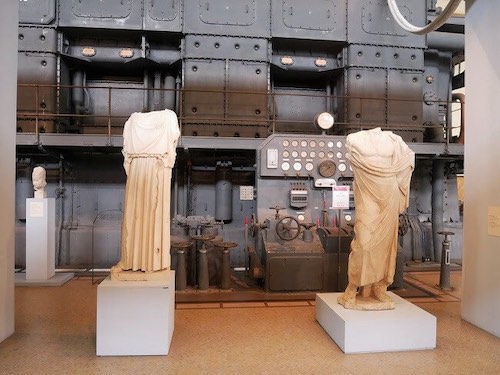
Musei Capitolini – Virtual Tour of one of Rome’s most famous museums
Musei Capitolini, the vast and beautiful art museum on top of the Capitoline Hill also offer a virtual tour.
You have a choice of two solutions
The first is again via google arts and culture, for which you only need an internet connection.
To access, click here , then click again on the yellow man on the right corner of the main image. A new page will open up with a selection of images from the museum: click on any that grabs your attention for a close-up!
If you have Flash player, you can also access the virtual tour offered by the museum itself here .
I personally find this second way to visit the museum way more enjoyable: I find the images clearer and the whole user experience smoother, however, it may take an extra minute for setting Flash Player up, should your computer not run it already (mine didn’t).
Thankfully, getting Flash is easy and free, as you can easily download it from the museum page itself. When given the options, follow the link and follow the prompts. I promise, it is very easy!
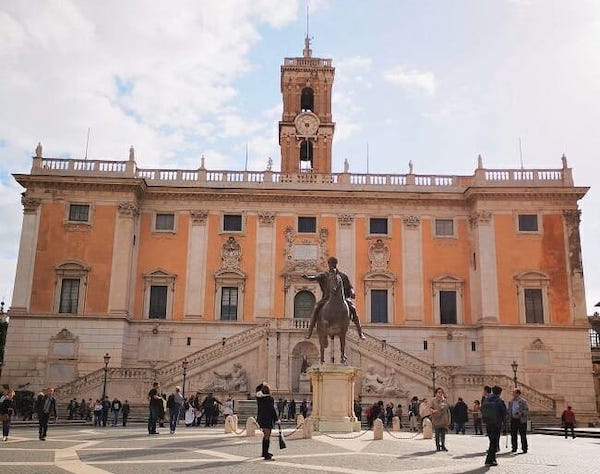
Mercati di Traiano -Trajan’s Market Rome Museum virtual Tour
Trajan’s markets are one of the most beautiful and interesting archaeological areas in Rome and one of the most underrated. I always recommend tourists to go visit and I was delighted to discover they also have a virtual your option and of excellent quality.
You can visit them virtually taking the tour form the museum site or via google arts and culture site.
The links are respectively:
Museum virtual tour (required flash player, follow the prompt from the museum page to install it if needed, it is free and easy to do)
Google arts and culture tour : click on the little yellow figurine and then on any image for a close up.
The markets give a wonderful insight into the history of the expansion of the Roman Empire and a shed a light on some aspects of Roman architecture very different yet equally beautiful to that found in the Roman Forum.
Museo dell’Ara Pacis virtual tour
The Ara Pacis is a huge altar (‘Ara’) dating back to 13-9BC. It was built to celebrate the return of Augustus from his military campaigns is Gallia and Spain and wanted to celebrate the start of a long period of peace ( pax, pacis in Latin, hence the name ‘ara pacis’, Peace Altar).
The altar is a wonderful example of Roman sculpture and a virtual tour of t works particularly well as it allows you to see the details from close up.
You can access it two ways:
Via google arts and culture here (not really a virtual tour, but a selection of images you can move around and see in close up)
Or via the museum itself, here . This is a much better and enjoyable option, however, it requires the use of Flash Player, which not all computers have. You can download it safely and fro free following the prompts on the museum page.
Museo Napoleonico – Napoleon’s Museum Rome Virtual Tour
Very different from the museums above but worth a visit is the Rome Napoleon’s Museum dedicated, as you guessed, to Napoleon himself!
As well as a good collection, I like this museum for its elegant interiors, which you can appreciate surprisingly well wit the virtual tour provided. Have a look here , aren’t the rooms themselves just wonderful?
Like for the museums above, Flash Player is needed: just follow the prompts on the page for a free download (no computer skills required!)
Carlo Bilotti Museum Rome Virtual Tour
A hugely underrated yet important museum in Rome is the Museum Carlo Bilotti, located in stunning Villa Borghese , an absolute must-see in Rome.

The museum has masterpieces by De Chirico, Warhol and Manzu and is a real hidden gem worth seeking our virtually and when in Rome!
You can visit it following this link to Google Arts and Culture . Click on the yellow figurine for a selection of images and then click on any that picks your interest for a closer look.
Museo di Villa Torlonia -Villa Torlonia Museum
Villa Torlonia is one of the most beautiful parks in Rome and one with important historical buildings with wonderfully decorated interiors.
The Villa is slightly out of the center of Rome and you may not be able to include it in your wanderings if you only have a day or two in Rome, however, it is worth seeing and a virtual tour may actually be the most convenient way to do so!
You can take the tour via the Museo di Villa Torlonia website itself clicking here (flash player required, follow the prompt to install if needed, it is free)
Or simply via the internet on the Google Arts and culture site here
I hope you enjoyed this overview of virtual tours of Rome museums you can take from the comfort of your own home and found the instruction to access them easy to follow.
Stay safe and happy museum ‘going’!
My name is Marta, I am a travel-loving mama born and bred in that messy, wonderful, infuriating, awe-inspiring unbelievably beautiful city that is Rome. A classics graduate and professional travel blogger, on this site I share my insider tips to help you plan your dream trip to Rome, Italy.
Children books about Rome for before, during and after your trip
Veal saltimbocca recipe: how to make and serve saltimbocca alla romana the rome way, you may also like, fun and interesting facts about the colosseum for..., christmas markets in rome you will love this..., how to see the best of rome in..., free things to do in rome you’ll love..., how to buy tickets for the pantheon +..., how to visit the spanish steps in rome:..., largo di torre argentina: all you need to..., 40+ rome hidden gems you’ll love, outdoor swimming pools in rome you’ll love this..., 22 fantastic things to do in rome when..., privacy overview.
- Archaeological sites
- The Trevi Fountain
- Vatican Museums
- Saint Peter’s Basilica
- Villa Borghese
- Piazza di Spagna
- Piazza Navona
- Colosseum tickets
- Vatican Museum tickets
- Sistine Chapel tickets
- Saint Peter’s Basilica tickets
- Colosseum tours
- Pantheon Tours
- Car rent with driver
- Transfer Rome / Fiumicino Airport
- Transfer Rome / Ciampino Airport
- Transfer Rome Civitavecchia
- Phone numbers
Saturnia Tellus relief – Altar of Peace, Rome
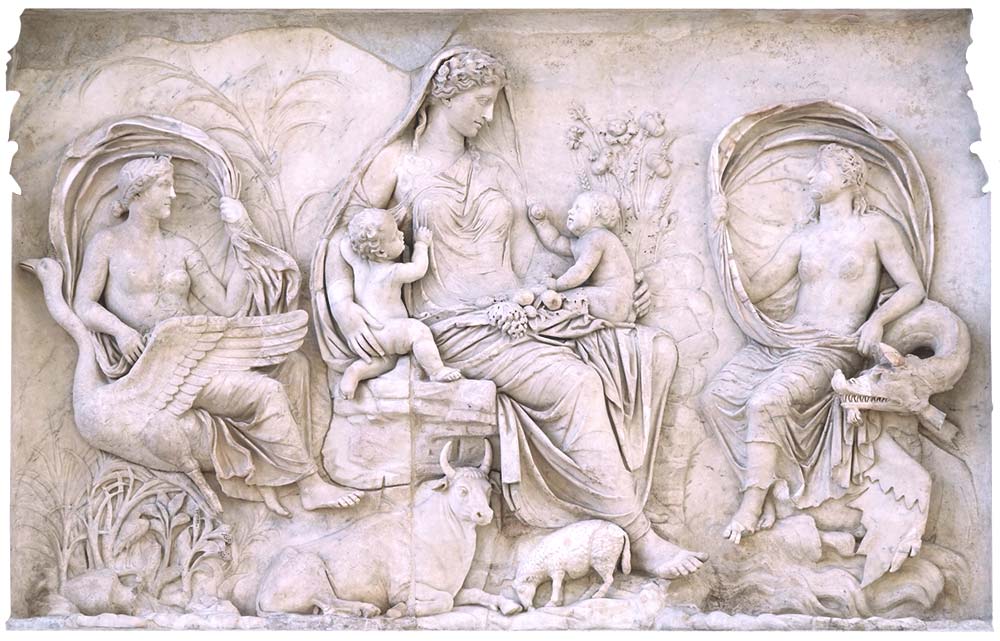
Saturnia Tellus relief – Altar of Peace
Saturnia Tellus is one of the four frontal reliefs of the Ara Pacis. In an excellent state of conservation, the relief represents three female figures. The first is seated on a swan, a symbol of air, the second has two cherubs in her arms, the third is seated on a sea dragon, a symbol of the sea.
wow. that is very informative.
Questo sito utilizza cookie tecnici e di profilazione. Proseguendo la navigazione acconsenti all'uso dei cookie. Maggiori informazioni . Accetto

recherche effectuée sur l'ensemble des web académique
Auguste et l'Ara Pacis
Naviguer dans la rubrique.
- Aquae Segestae - Sceaux en Gâtinais
- Présages et prémonitions à Rome
- Auguste et l'Ara Pacis
- Voyage réel, voyage mythique
- Les spectacles à Rome
Les objectifs du site
ce site a été conçu pour des latinistes de cycle 4. il permet notamment d’aborder le thème proposé au programme de 3ème : « l'empire romain » - la paix romaine, la romanisation de l'empire ». il n'est pas aisé pour ces élèves d'aborder la vie politique romaine, surtout si l'on veut les rendre sensibles à l'aspect idéologique d'un programme politique. le sujet peut sembler bien aride... les pages publiées ont pour objectif de présenter, de manière aussi accessible que possible, l'idéologie mise en place par auguste et d'établir un rapport entre urbanisme et programme politique: il est intéressant de montrer à nos élèves que des idées politiques peuvent s'inscrire concrètement dans les murs de la ville, et que les monuments, et de manière plus large les arts décoratifs, mettent en scène l'image que le pouvoir veut donner de lui-même., pour que les élèves entrent plus aisément dans l'étude du monument, et dans la démarche ci-dessus, il nous a paru utile de fournir des documents sur le contexte de la construction de l'ara pacis: contexte historique, évoqué à travers le personnage d'auguste, et contexte géographique (comment le monument s'insère dans la ville). ces pages donnent des informations simples, que les élèves peuvent consulter en autonomie., le site a été construit pour que l'élève y trouve une documentation à sa portée, et qu'il puisse donc, à travers les trois parties, faire des recherches en suivant un fil directeur: par exemple, le thème de la pietas, l'utilisation des mythes dans la politique augustéenne, etc., les modalités de consultation, pour une consultation en ligne: nous avons essayé de produire des pages qui ne soient pas trop "lourdes", mais certaines contiennent beaucoup d'images et demandent un certain temps de chargement si la connexion est lente. c'est pourquoi vous pouvez aussi télécharger le site pour l'installer sur un disque dur ou sur un serveur en intranet, dans le cadre d'activités éducatives à but non lucratif. pour une consultation hors connexion: vous pouvez télécharger les différentes parties du site en format compressé (.zip) - vous aurez alors besoin du logiciel adapté pour le décompresser. sont disponibles:, - l'intégralité du site (5214 k)., - la première partie sur auguste (1345k),, - la deuxième sur la présentation générale du monument (547k), - la troisième sur l'analyse des bas-reliefs du monument (3318k), ces dossiers compressés ne contiennent pas les activités en version rtf., les activités proposées le sont en deux versions: en version internet (fichier html), ou en version traitement de texte (fichier rtf) téléchargeable à partir de la page internet de l'activité, afin que les élèves puissent répondre directement sur traitement de texte. vous pouvez aussi télécharger l'ensemble de ces exercices (2839k) en format compressé (de manière indépendante du reste du site). pour des raisons de poids informatique, les fichiers rtf sont moins complets que la version internet des mêmes fichiers., les activités (textes et analyses d'image), les activités sont matérialisées dans le site par une animation représentant une couronne de laurier qui verdit peu à peu., nous avons fait le choix, dans la mesure où ce site est avant tout conçu pour être utilisé dans un cadre scolaire, de ne pas donner de correction aux questions posées., le site lie la lecture de l'image et la lecture de textes latins, l'un complétant l'autre autant que possible. les textes cités ci-dessous accompagnent souvent la lecture de telle ou telle partie du monument, voire d'images complémentaires., certains textes sont accompagnés de leur lexique qui apparaît sur la page même de l'activité, si le texte est court, ou qui s'ouvre dans une nouvelle fenêtre., a ces activités s'ajoutent quelques tests interactifs, qui sont souvent plus proches du jeu:, - sur auguste, - sur le lexique des motifs décoratifs (en français), - sur l'analyse de la scène représentant enée sacrifiant sur le site de lavinium, - sur le lexique de base à connaître pour lire le texte des fastes, d'ovide: "auguste, un nouveau romulus", - promenade dans une galerie de portraits., voir le document élève ., droits d'usage, les images de ce site, sauf indications contraires, ont été prises et numérisées par les auteurs... ou leurs amis mis à contribution; elles sont à la disposition de tous ceux qui veulent les employer dans un cadre éducatif non commercial; toutefois, si vous désirez les utiliser pour une publication sur internet - toujours dans un cadre éducatif non commercial-, merci de nous en avertir et d'indiquer leur provenance par un lien sur la page d'origine., pour rendre à césar..., des outils très utiles , le lexique a été établi grâce au logiciel collatinus, réalisé par yves ouvrard, qui permet de gagner beaucoup de temps. vous pouvez le télécharger. il est gratuit., les pages interactives du site ont été réalisées à l'aide du logiciel hot potatoes, que l'on peut télécharger et utiliser gratuitement dans un cadre éducatif. , des remerciements, les membres de la mrsh de caen, qui ont eu la gentillesse de nous autoriser à utiliser les images virtuelles qu'ils ont élaborées., les dessins ont été réalisés par un professeur d'art plastiques, rené lefèvre, qui plonge à intervalles réguliers dans le monde antique et ne s'étonne plus des demandes les plus saugrenues (comme s'user les yeux à la loupe pour dessiner une monnaie polie par le temps...)., les élèves latinistes du collège beaulieu, à joué-les-tours, ont tapé certains textes et contribué à l'élaboration de questionnaires avec leur professeur, jean-paul le simple., des erreurs et des améliorations, par contre, des erreurs ont pu se glisser ici et là, et ... nous les avons faites sans l'aide de personne. merci de penser à nous les signaler de même, si vous pensez à des ajouts intéressants ou que vous voulez faire part de votre utilisation du site avec les élèves, écrivez-nous, royo sylvie, pour aller plus loin: le fil rss edubase.

IMAGES
VIDEO
COMMENTS
Quick & Easy Purchase Process! Full Refund Available up to 24 Hours Before Your Date. Top Rated Activities! Quick & Easy Purchase, Cancel Up To 24H Before Your Tour.
Ara Pacis - page d'accueil. Auguste et l' Ara Pacis: un homme politique qui veut inscrire sa domination dans les murs de la ville. Auguste. Ara Pacis. Bas-reliefs. Sommaire. langues anciennes. Informations sur le site. Sylvie Royo, Manuel Royo, avec la collaboration de Jean-Paul Le Simple.
Book the most popular Guided tours in Ara Pacis. Best price and money back guarantee! Read the reviews of your fellow travelers. Language: English En. Currency: USD ($) Wishlist; Cart; Help; Profile; Skip to content. Search. Add dates. Ara Pacis Guided tours. Our most recommended Ara Pacis Guided tours. 1. Roma Pass: 48 or 72-Hour City Card ...
The Ara Pacis, or Altar of Peace, is one of Ancient Rome's most significant monuments. Built in the 1st century BC, this 2,000 year old altar symbolizes the peace and prosperity of Emperor Augustus's reign. When the Roman Senate commissioned the Ara Pacis, Augustus had triumphantly returned from conquering Spain and Gaul.
The Ara Pacis is an exciting example of Roman sculpture in the early times. The altar of pease is the monument that commemorates the victories of Augustus and symbolizes the establishment of peace in the Roman Empire (the "Pax", a particularly vital concept during the reign of Augustus) after about one hundred years of wars.. History. Voted by Sena to , the Ara Pacis Augustae or Altar of ...
Les activités proposées le sont en deux versions: en version internet (fichier HTML), ou en version traitement de texte (fichier RTF) téléchargeable à partir de la page internet de l'activité, afin que les élèves puissent répondre directement sur traitement de texte. Vous pouvez aussi télécharger l'ensemble de ces exercices (2839K ...
Ara Pacis Bas-reliefs . biographie en douze questions. portraits d'Auguste. Auguste constructeur de la ville. Chaque partie des pages sur Auguste a sa couleur: verte pour la biographie, jaune pour les portraits, rose pour les constructions d'Auguste à Rome. Une icône (couronne, portrait ou carte) permet de revenir au sommaire de chaque partie
Ara Pacis. Tours. Our most recommended Ara Pacis Tours. 1. Roma Pass: 48 or 72-Hour City Card with Transport ...
The Ara Pacis Augustae, or Altar of Augustan Peace in Rome, is one of the most important and well-preserved examples of Roman art and architecture still surviving today. The altar was built to celebrate the peace and prosperity brought to the Roman Empire during the reign of Emperor Augustus ( Pax Romana or Pax Augusta) and is now a must-see ...
Ara Pacis : le déroulement de la procession. 4 Juillet 13 av. J.-C. Problème pour archéologues avertis... Pourquoi y en a-t-il qui marchent en sens inverse? Cependant, certains détails prouvent qu' il ne s'agit pas d'une représentation fidèle de la réalité de l'événement: ce n'est pas le souci de l'exactitude historique qui prédomine.
MUSEUM VIDEO GUIDE. Video guide on the permanent exhibition of the museum in Italian, English, French, German, Spanish: € 7,00. The video guide can be purchased directly from the ticket office and is supplied to the visitor already sanitised in a sealed sachet and with a disposable headset. Museum app available on the IOS and Android stores.
The Ara Pacis is, at its simplest, an open-air altar for blood sacrifice associated with the Roman state religion. The ritual slaughtering and offering of animals in Roman religion was routine, and such rites usually took place outdoors. The placement of the Ara Pacis in the Campus Martius (Field of Mars) along the Via Lata (now the Via del ...
An open-air altar for sacrifice. The Ara Pacis is, at its simplest, an open-air altar for blood sacrifice associated with the Roman state religion. The ritual slaughtering and offering of animals in Roman religion was routine, and such rites usually took place outdoors. The placement of the Ara Pacis in the Campus Martius (Field of Mars) along ...
Les circonstances de la construction de l'. Ara Pacis. La dédicace, c'est à dire la cérémonie de consécration solennelle aux dieux qui marque de début du fonctionnement de l'édifice, n'aura lieu que plus tard, en 9 avant Jésus-Christ, le 30 Janvier. La date a son importance: c'est le jour de l'anniversaire de l'épouse d'Auguste, Livie ...
Remember to step back and take in the surroundings, too—the juxtaposition of the ancient altar against the crisp modernity of the museum designed by architect Richard Meier is a dialogue across time that Rome narrates so well. 📌 Address. Lungotevere in Augusta, 00186 Roma RM, Italy. ⏰ Opening Hours. 8:00 AM - 5:00 PM.
Ara Pacis Bas-reliefs. La situation de l'Ara Pacis dans Rome, sous Auguste et aujourd'hui Les autres monuments de la zone: horologium, mausolée et ustrinum. sommaire. Présentation générale du monument. Les circonstances de la construction du monument Le texte des Res Gestae. Qu'est-ce qu'un autel? ...
zone de l'Ara Pacis - ara pacis. Carte: d'après un plan de P.Bigot. Cliquer sur l'image pour accéder à un plan précis de la zone. Quatre monuments vont être édifiés par Auguste sur la même zone. Le mausolée d'Auguste est le premier construit, à partir de 28 av. J. -C.; à proximité se trouve l' ustrinum. L'obélisque de l' horologium ...
When Ara Pacis Museum opened along the banks of the Tiber River in 2006, it caused quite the stir. Designed by international architect Richard Meier, the museum's stark steel, glass and travertine facade sharply divided opinion, with some crying heresy that such a modernist structure would house the Ara Pacis, one of the most significant monuments of Ancient Rome.
Museo dell'Ara Pacis virtual tour The Ara Pacis is a huge altar ('Ara') dating back to 13-9BC. It was built to celebrate the return of Augustus from his military campaigns is Gallia and Spain and wanted to celebrate the start of a long period of peace ( pax, pacis in Latin, hence the name 'ara pacis', Peace Altar).
Ara Pacis: un autel. Ara Pacis. : un autel. L'autel - ara - est dans le cas qui nous occupe une sorte de petit temple à ciel ouvert, enclos de murs, fermé par une porte. C'est un espace consacré, comme les autres temples, à une divinité. Cette divinité peut être une idée abstraite, une vertu que l'on veut mettre en valeur en la ...
Ara Pacis: disposition des bas-reliefs. La disposition des bas-reliefs a une signification. D'un côté se trouvent les bas-reliefs qui renvoient aux origines mythiques de Rome; l'autre côté renvoie, à travers des allégories, à l'époque contemporaine du monument: d'un côté un passé glorieux qui prépare et annonce, de l'autre côté ...
Saturnia Tellus relief - Altar of Peace. Saturnia Tellus is one of the four frontal reliefs of the Ara Pacis. In an excellent state of conservation, the relief represents three female figures. The first is seated on a swan, a symbol of air, the second has two cherubs in her arms, the third is seated on a sea dragon, a symbol of the sea. 4.
Les activités proposées le sont en deux versions: en version internet (fichier HTML), ou en version traitement de texte (fichier RTF) téléchargeable à partir de la page internet de l'activité, afin que les élèves puissent répondre directement sur traitement de texte. Vous pouvez aussi télécharger l'ensemble de ces exercices (2839K ...